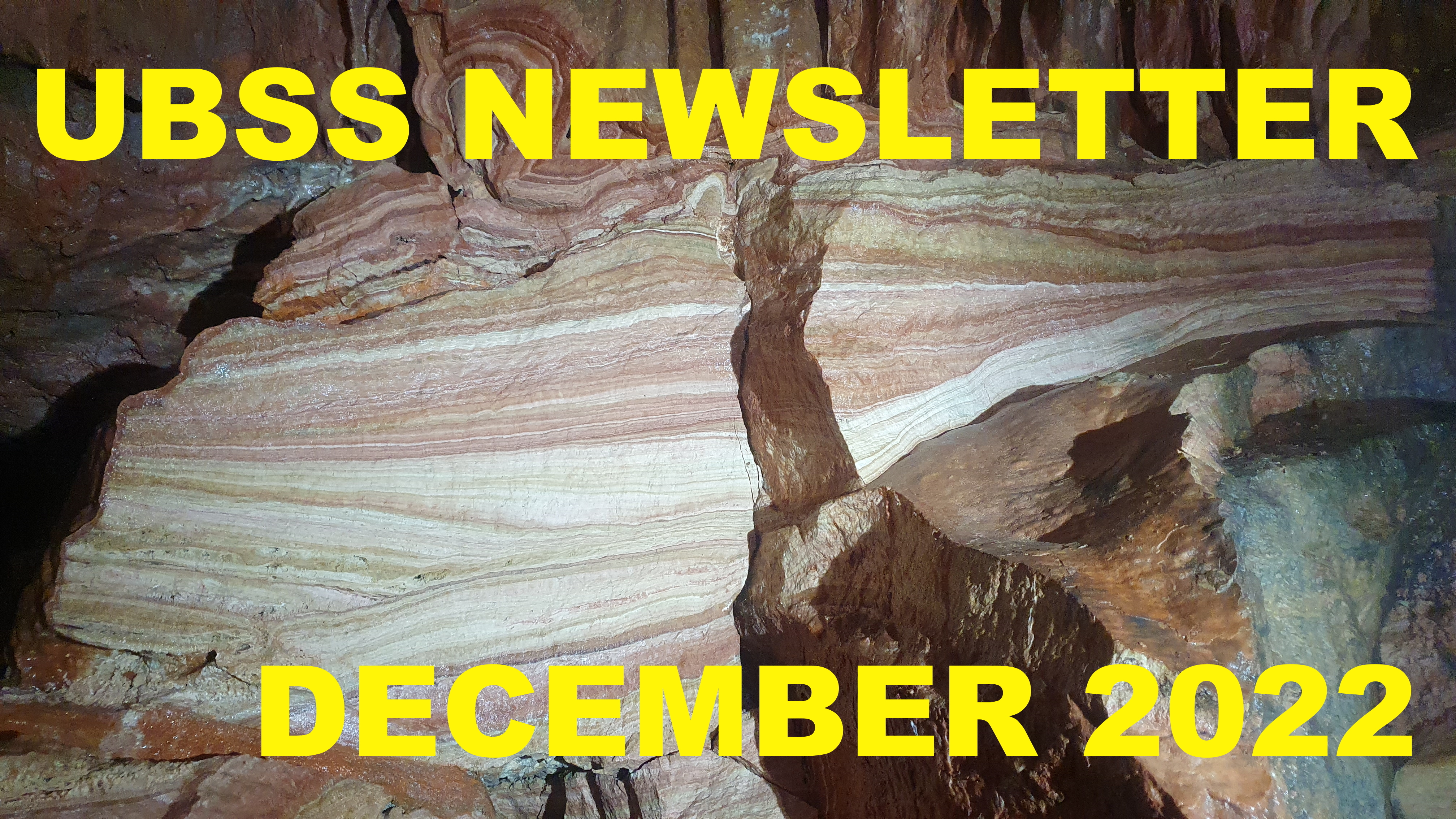
Section through stal in Kent's Cavern, Torquay, Devon.
|
|
Your
hard-working newsletter team would like to wish all our readers the
compliments of the season and very worm wishes for 2023! December is
often a quiet season for caving, but we've done our best to rustle up a
few things for you to read so that the new year can start with some
customary procrastination!
Thanks to the diligent performance of the rituals at the Hut (and the
consumption of yet more turkey!), the sun rose again on New Year's Day
and all was well.
There's more caving to look forward to this term, and if you haven't
gone underground yet, there's still plenty of time to get involved.
You can find all the back issues of the monthly newsletter online. So if you're sitting in a dull lecture, take a look at what the club has been up in past months and years.
Linda and Zac
|
|
DIARY DATES
Post-exams Mendip weekend January 21st - 22nd
We'll be staying in the MNRC (Mendip Nature Research Committee) so it
will be extra luxurious (think real toilets) and there are no hut fees!
Sign up here.
UBSS x UBES x UBMC Yorkshire weekend February 24th - 26th
In February we'll be teaming up with the Expeditions Society and
Mountaineering Club for a crossover weekend in Ribblesdale. Further
details and signups will be released at a later date - put it in your
calendar!
UBSS AGM and Dinner March 11th
The AGM will take place in the Geography Department on University Road
at 10.30am. Room details to follow. The Annual Dinner will be in the
evening. Details to be confirmed.
SCHECC in March
For those of you who missed this year's CHECC (or just really want
another one), UBSS will be attending Southern CHECC in South Wales this
March. Exact dates TBC.
|
|
SANTA'S STUCK IN THE SNOW!
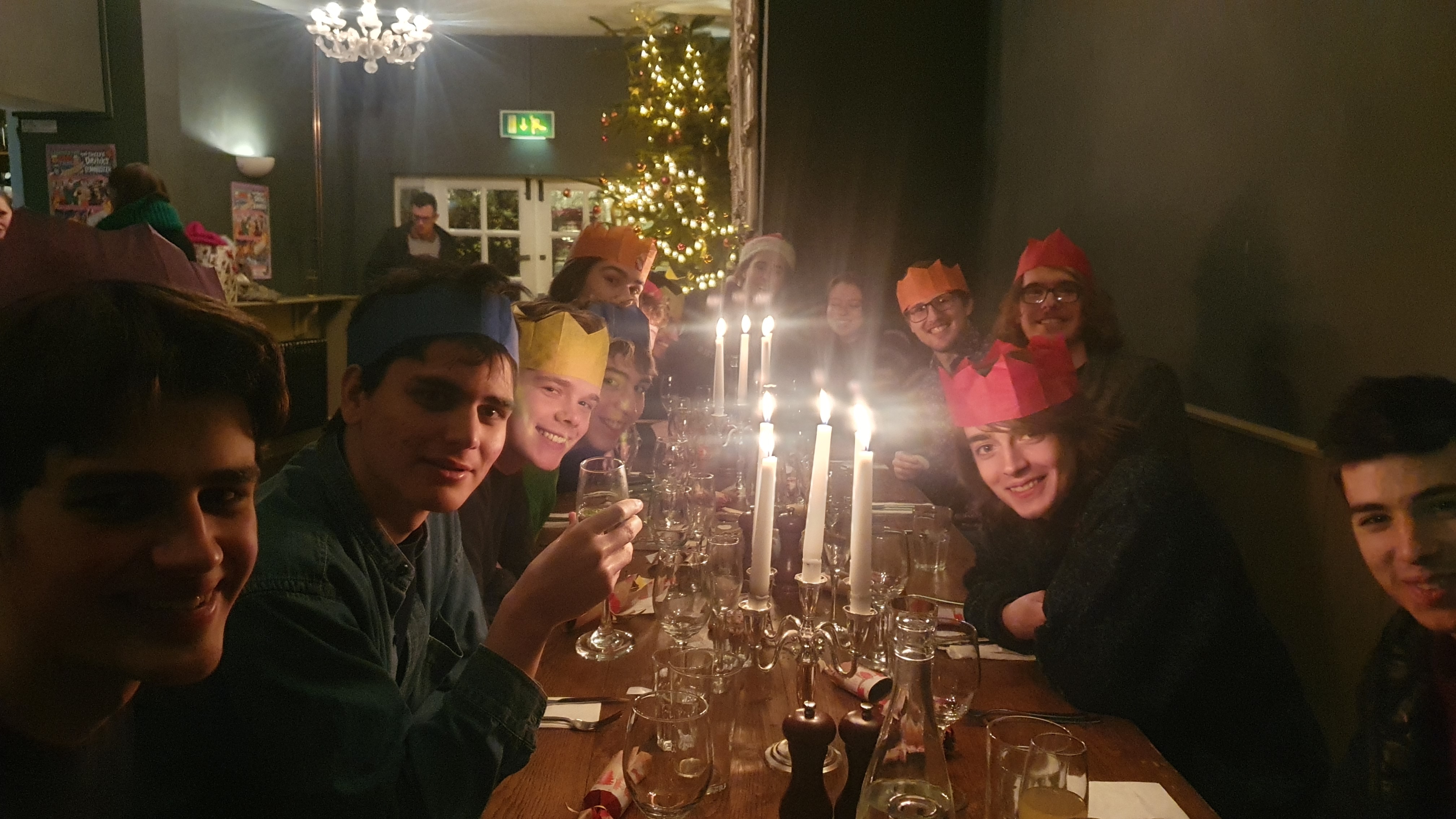
Henry Morgan did an excellent job organising the Christmas
dinner at The Spotted Cow in Bedminster, but unfortunately he ended up
stranded in Prague with several other UBSS members after a long weekend
turned into an even longer weekend due to snow. So this year, Santa will
kindly be calling twice.
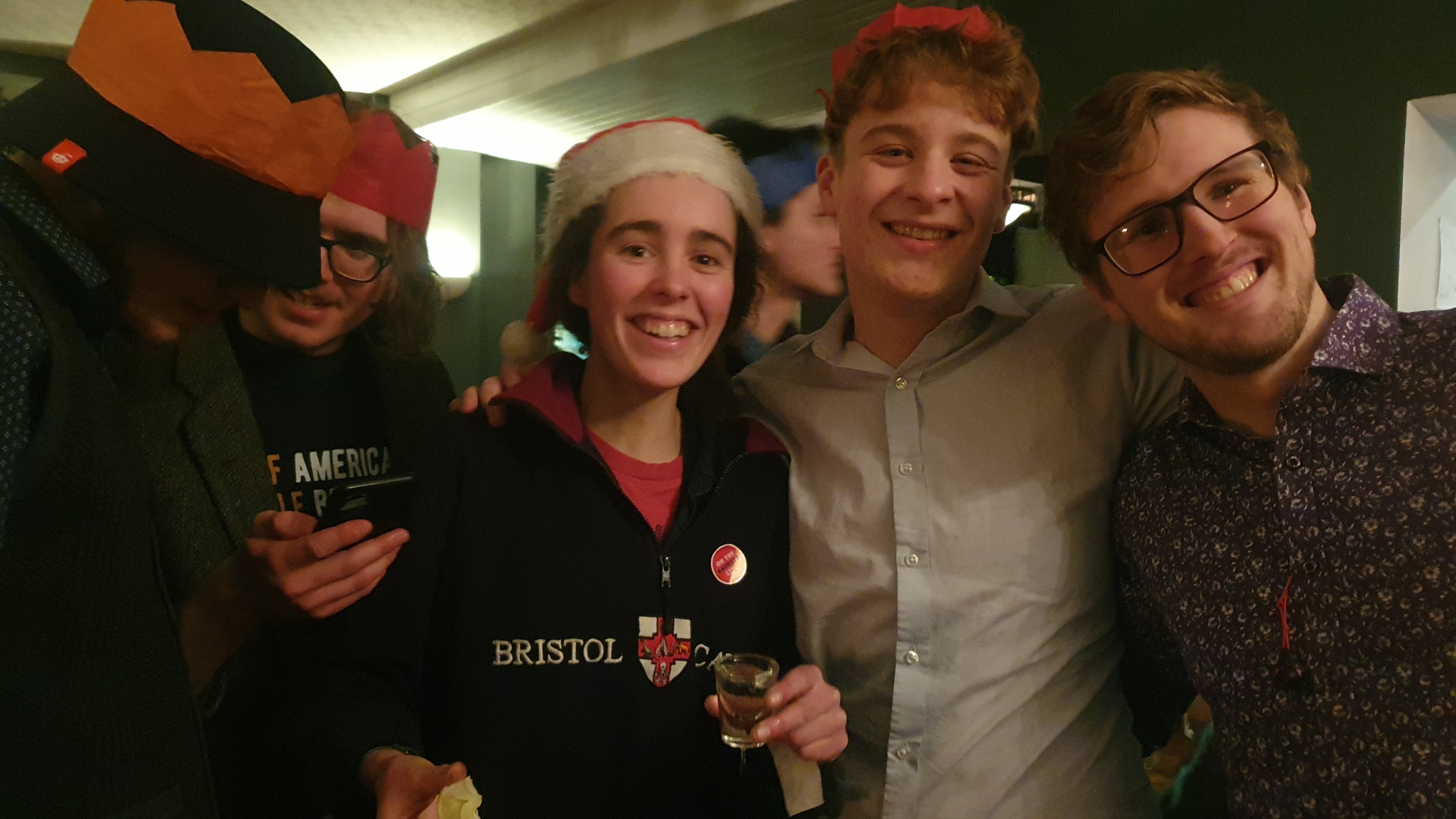
The Spotted Cow were very accommodating with all the last minute
changes, some of which were being made only hours before the start of
the meal,but all ended up well when 22 people turned up for a night of
good food and plenty of fun. A UBSS team even came second in the pub
quiz later that night.
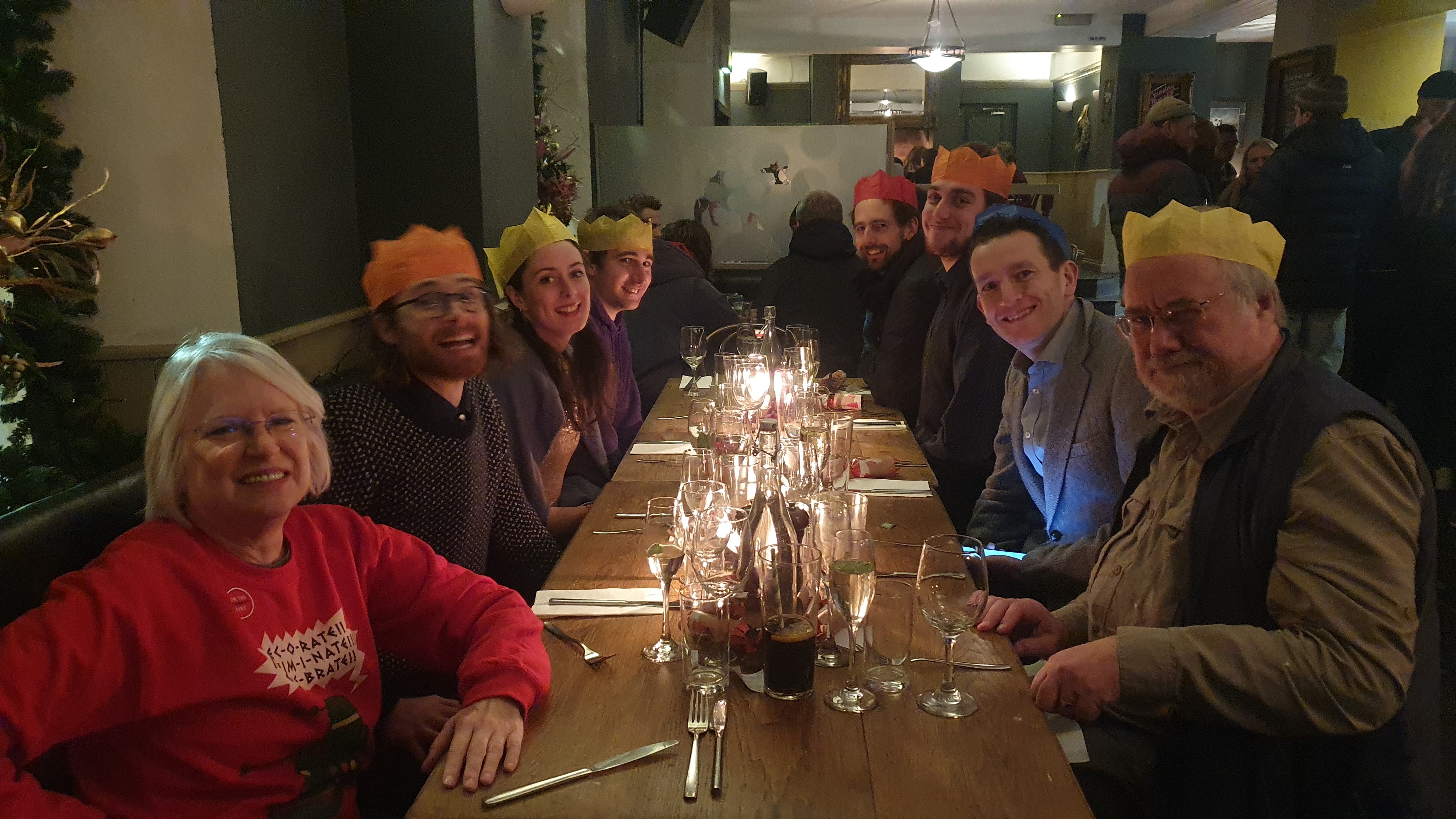
Elliott McCall kindly stepped into the breach and became Organising
Overworm, making sure everyone got their meals (although he's still
hunting down the person who ate his dessert!) and that Santa remembered
whose presents were delayed due to more snow than even he could cope
with.

Secret Santa presents were handed out with the prize for the most
inventive going to the one Michael Farmer received - a Fimo model of
Augustus, his recent frog tattoo.

Augustus, we'd like to introduce you to Augustus!
|
|
HEAVY NIGHT, TIME FOR A NAP!
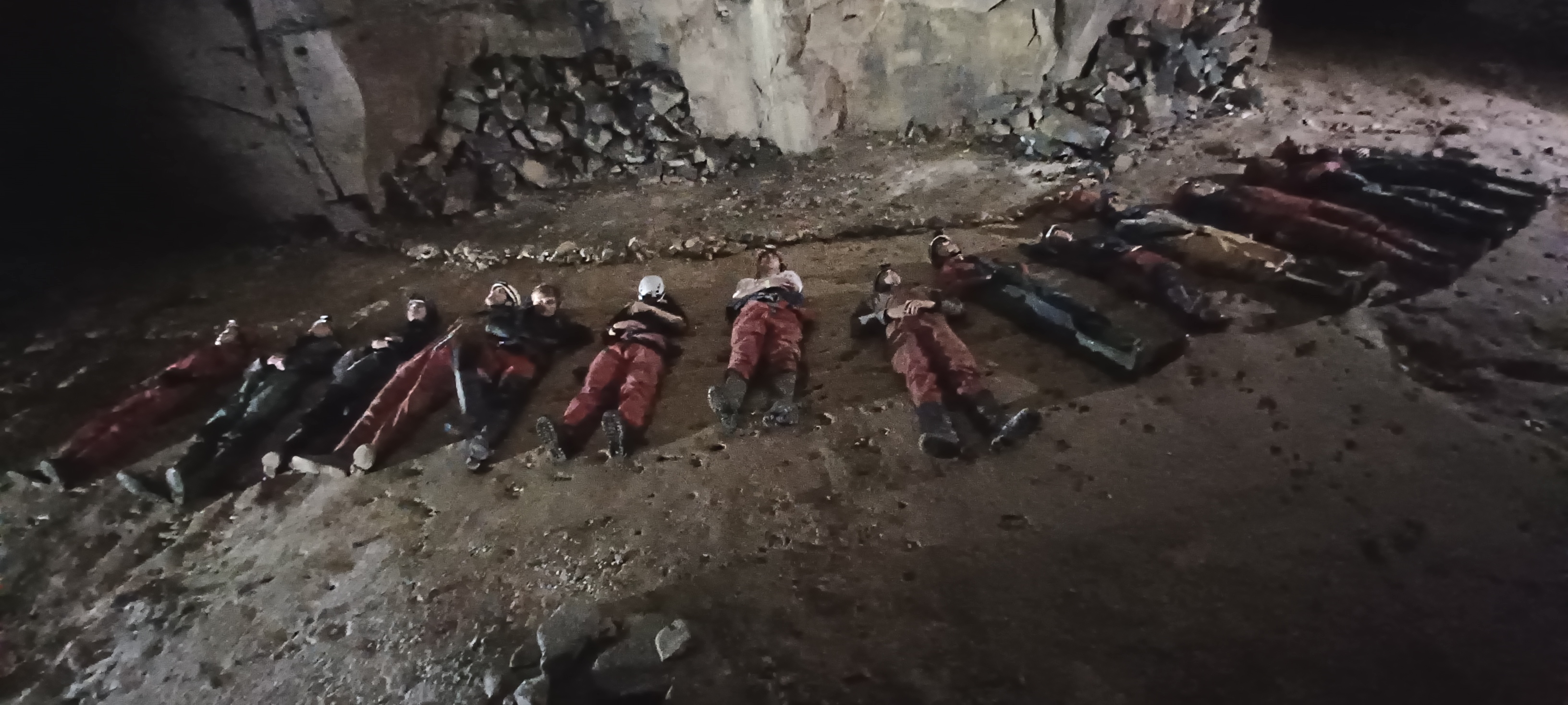
Railway Sleepers, Brown's Folly, Bathford.
UBSS members have a long history of
wandering around Bath stone quarries after an excess of alcohol, and
this year's CHECC weekend proved to be no exception to that rule, as Zac
woodford relates ...
So, it was CHECC… need I say more? Oh, all right. Well, naturally given
the Friday evening’s activities, re. excessive drinking, caving wasn’t
many people’s priority among UBSS members. Not least because we were on
Mendip and therefore not really wasting any opportunities that we
wouldn’t be able to take advantage of the rest of the year. I was only
looking to do something light and then maybe go the pub. This plan was
scuppered over breakfast when Merryn revealed that Cambridge was going
to a mine. Naturally my curiosity was kidnapped and after the brisk
kilometre stroll back to the campsite I had a brief elucidating chat
with Johno.
He'd heard of the Bathford sidings tunnel and wanted to investigate. I
explained that it would be a terrible trip and that Brown’s Folly Quarry
would be much more entertaining. After much Faff we were on our way.
However, I’d forgotten that it was the first Saturday of the Bath
Christmas market and there was a train strike. Now I’ve lived in Bath my
entire life and I have never, NEVER, seen the traffic as bad as it was
then. Usually abandoned village roads were clogged with cars. Roads that
rarely see even pedestrians were jammed. But utilizing every rat run I
know of, I managed to get to my parents’ house where we stopped for tea
and mince pies while we waited for the others to cross the city; a task
particularly difficult for Johno as he also had to negotiate the clean
air zone.
Having just finished my tea, I received a message from Johno say that
they were all waiting for us at the Brown’s Folly car park. Dashing
over, I quickly parked and changed just at the top of Farleigh rise
before jogging down to them. Upon arriving at the car park, a member of
Cambridge looked at me in my old Barbour coat and tatty trousers and
asked: “Are you going to get changed” to which I quipped, “I am”.
There were some signs of what was to come before we even got to Muddy
Hole as various small mobs sauntered after their guide arriving
piecemeal at the entrance. We counted that there was about 17 of us.
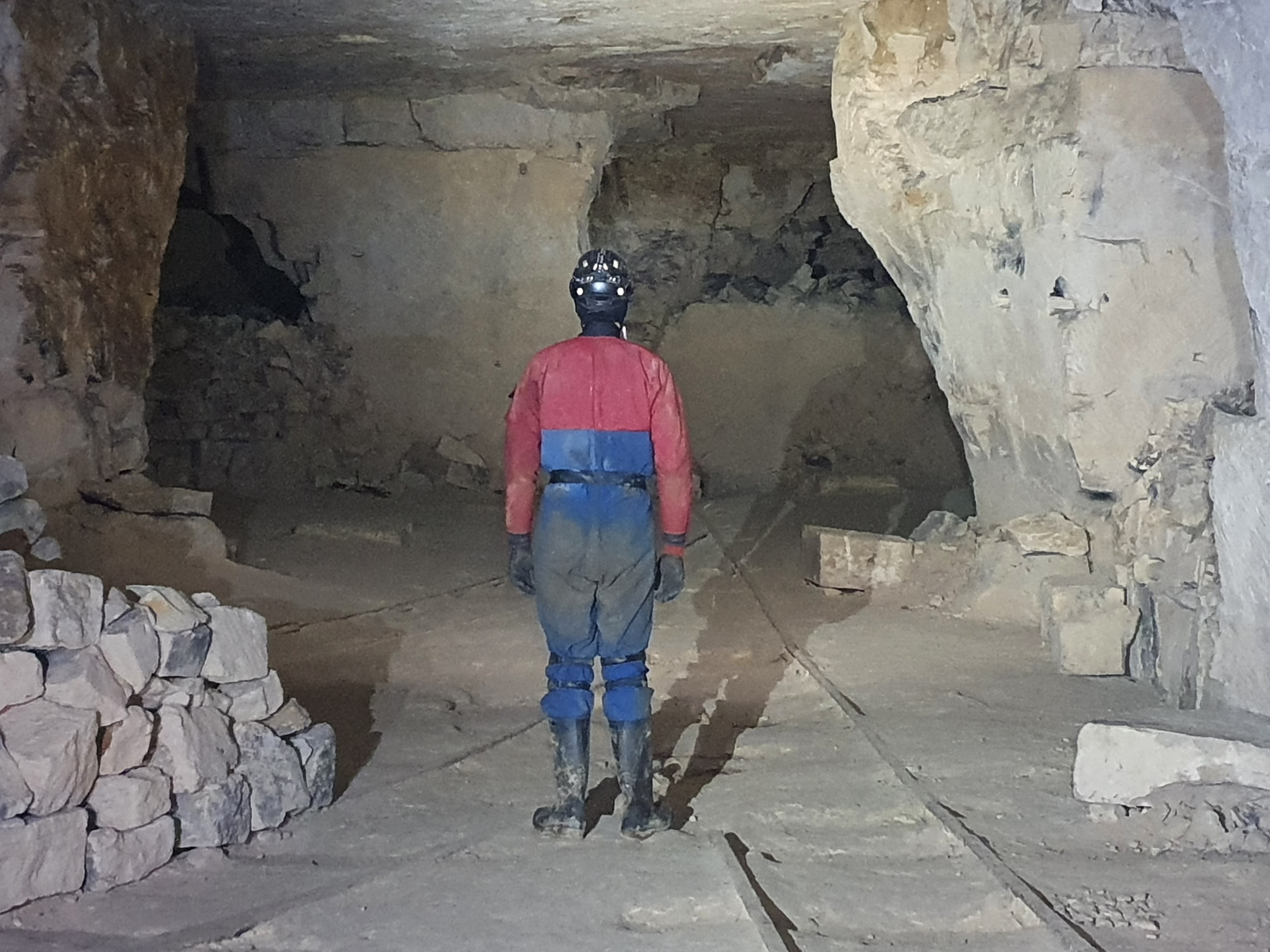
Zac Woodford at Clapham Junction. Photo by Linda Wilson.
We started well, entering and moving
swiftly on to Clapham Junction. We then proceeded to Back Passage. It
was here where things got complicated as various individuals wandered
hither and thither. So we found ourselves among the deads between Back
Passage and the passage south of Clapham Junction. Fortunately, I found
the small doorway between the two and we popped through to the other
side. I then swiftly led people back to Clapham Junction to show them
how turned around you can get. It was then that we lost Johno and three
others, having literally just counted how many were with us.
With no better idea than to continue hoping to find them on the way, and
if not have me go back in to find them once everyone else was out, we
continued. Heading up Middle Passage people seemed a lot more eager to
stick together, for some reason. Fortunately, we caught up with the
group we’d lost at the side passage that leads to the Crane and Devil’s
Chamber. We proceeded, taking our time in Devil’s Chamber to practice
our humming and photography.
Jumping from Devil’s Chamber to Front Passage we wandered south to the
Stables. I got there first to discover some previous visitor had left a
parting gift in the corner, I need not describe what, but I struggle to
believe that they couldn’t hold it until they got out.
At that point, we turned around and took Front Passage back north,
stopping at the calcite falls on the way, before reaching the old rail
cart. We posed there for a group picture in an attempt to win the CHECC
photo competition. The prize for which was 200m of rope which we agreed
to split evenly between the two clubs in the event of success.
From the rail cart we swiftly exited via Muddy Hole, changed quickly and
then headed back to CHECC for a night of drunken antics.
Zac Woodford
|
|
SEATHWAITE GRAPHITE MINE, BORROWDALE, CUMBRIA
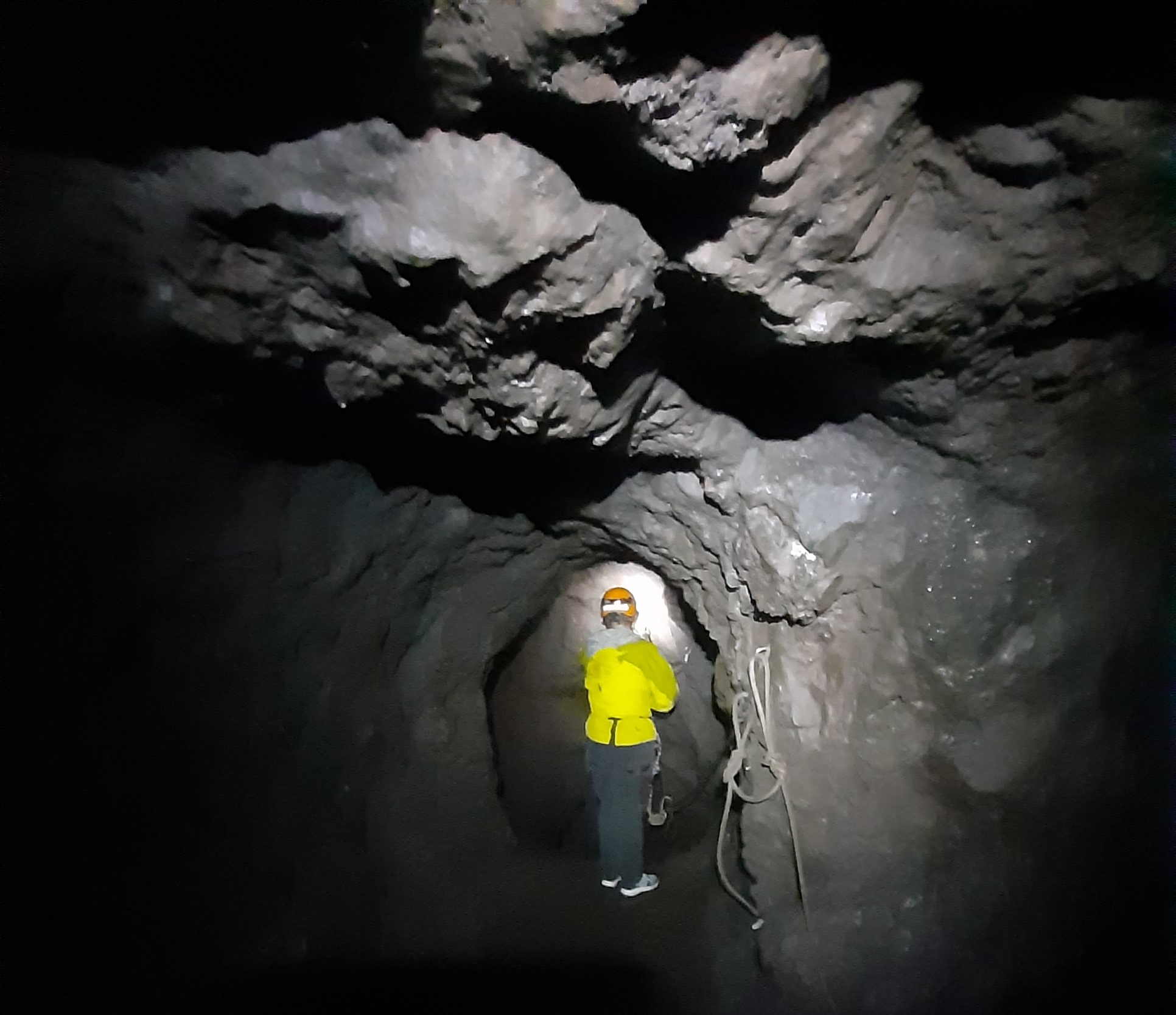
Seathwaite Graphite Mine, photo by Mandy Glanvill.
Cumbria isn't the first place that
springs to mind when looking for an underground trip, but there are
plenty of excellent mines to visit around there. Sally Britton describes
one such trip.
It’s been a while since I ventured underground, but who could resist an
abseiling through-trip in a pencil mine…? It’s graphite actually, the
only high quality deposit in the UK and one of only two in the world in a
volcanic series - made up of volcanic debris formed c.450 million years
ago.
Mining of graphite (previously known as black lead or plumbago) started in the 16th
century and continued for about 300 years - originally by locals who
used it to mark their sheep (and allegedly invented pencils). It was
more commercially exploited once German mining engineers arrived in the
late 16th century and was used to coat cannon ball moulds. The price by the early 19th century had risen to £5,000 a ton. The mine closed in 1891.
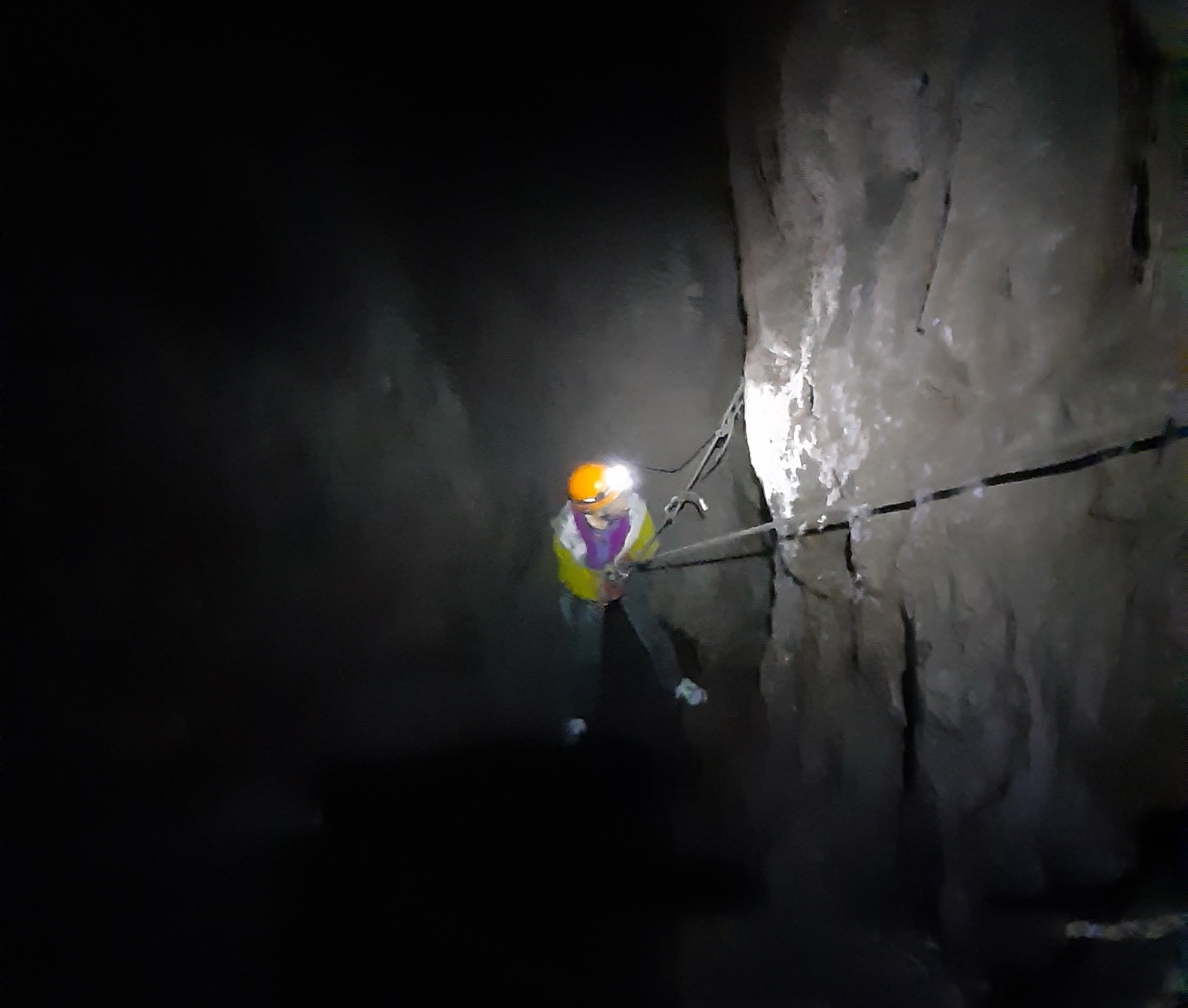
Seathwaite Graphite Mine, photo by Mandy Glanvill.
The mine/land is owned by the National
Trust and there are no access restrictions, though the NT are keen to
discourage ‘casual’ visitors to the mine which is an SSSI. There is road
parking at Seathwaite and access is through an arch in the farm
buildings, across the River Derwent and then up a long, winding not very
obvious path, though the spoil heaps make the general direction clear.
There are several entrances; we reached the top entrance (Gills Stage)
in about 50 minutes.
There are various horizontal levels and several pitches as well as the
through-trip pitches. There are some tram lines in evidence and
occasional remnants of wooden ladder rungs. The through-trip pitches and
traverses are all bolted and there were ropes in place on all of them,
though we took ropes with us.
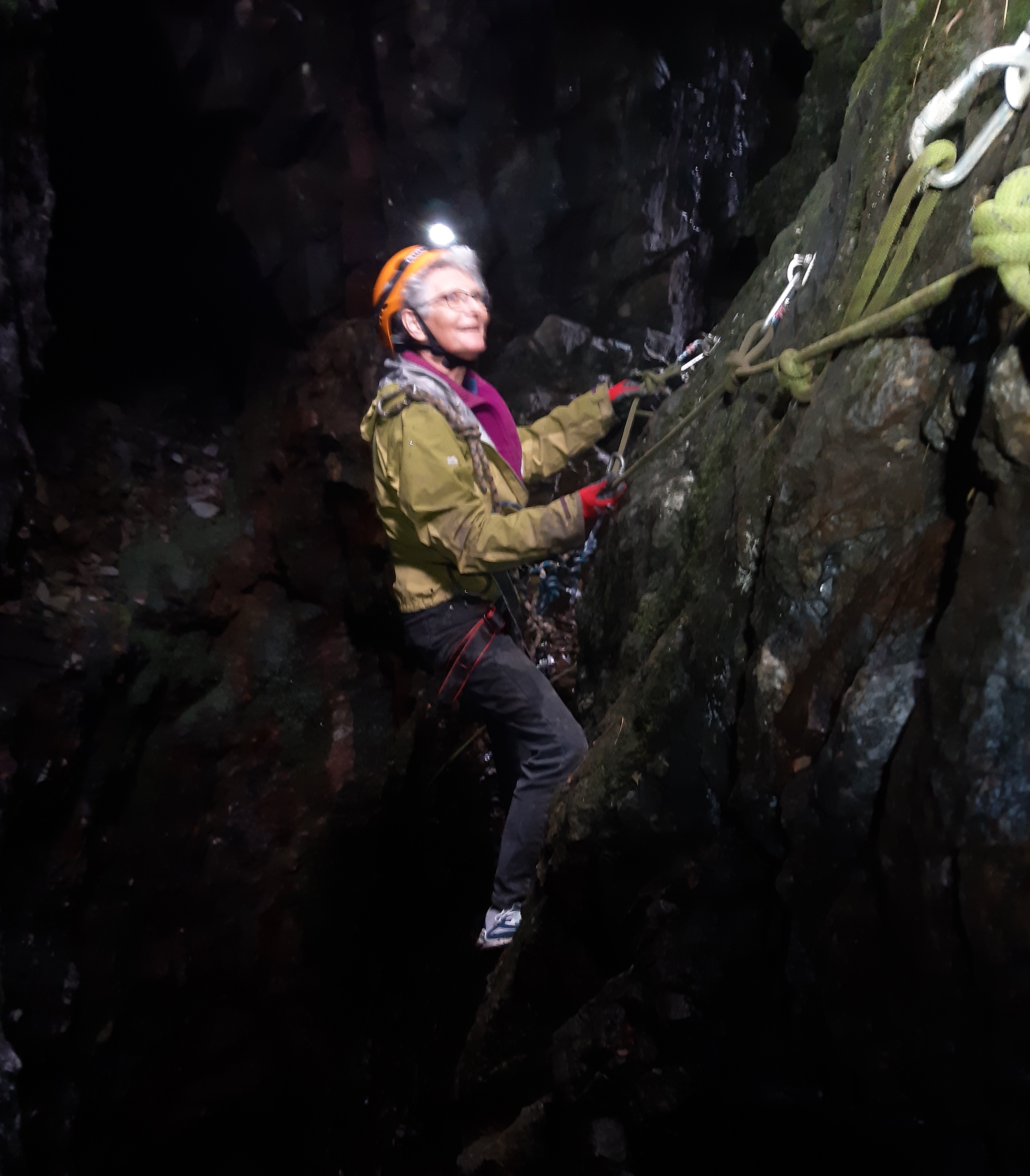
Seathwaite Graphite Mine, photo by Mandy Glanvill.
The first four pitches (11m, 6m, 10m, 18m)
follow each other in quick succession, with a traverse between the
second and third, and various short and longer passages leading off. The
Farey’s Level exit is reached by traversing around the top of the Grand
Pipe – a bit disconcerting as it is very unstable and crumbles away as
you cross it.
We exited here, having decided against the very wet 5th (24m) and 6th (55m in three stages) pitches and found a slightly clearer route back down the fellside.
Sally Britton
|
|
A ROMP DOWN READ'S
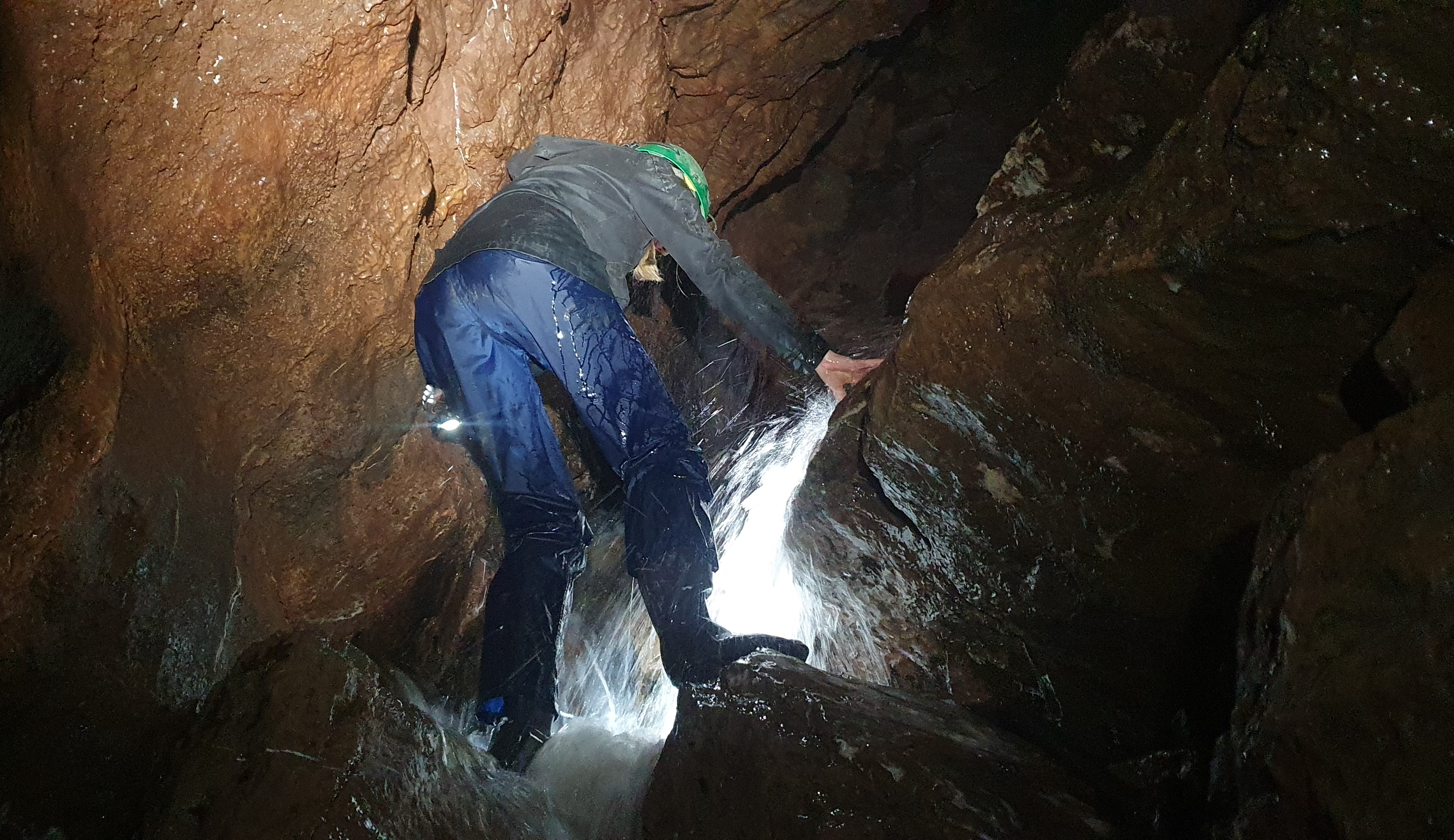
Alice Holland in the entrance to Read's Cavern. Photo by Linda Wilson.
As part of a quick recce for an
archaeological dig next year, Linda Wilson visited Read's Cavern with
Graham Mullan, Kostas Trimmis and Alice Holland.
OK, I admit it, I failed to adequately brief caver and archaeologist
Kostas about our trip to Read's Cavern, but in my defence, Kostas has
been caving for years! It has been a tad wet recently, so a change of
clothes might have been advisable, especially as he had to meet the new
Head of Department that afternoon! Alice, recently back from a South
Wales weekend had brought waterproofs and boots, while Kostas was doing
his best to keep his feet dry while navigating the not inconsiderable
stream pouring into the cave.
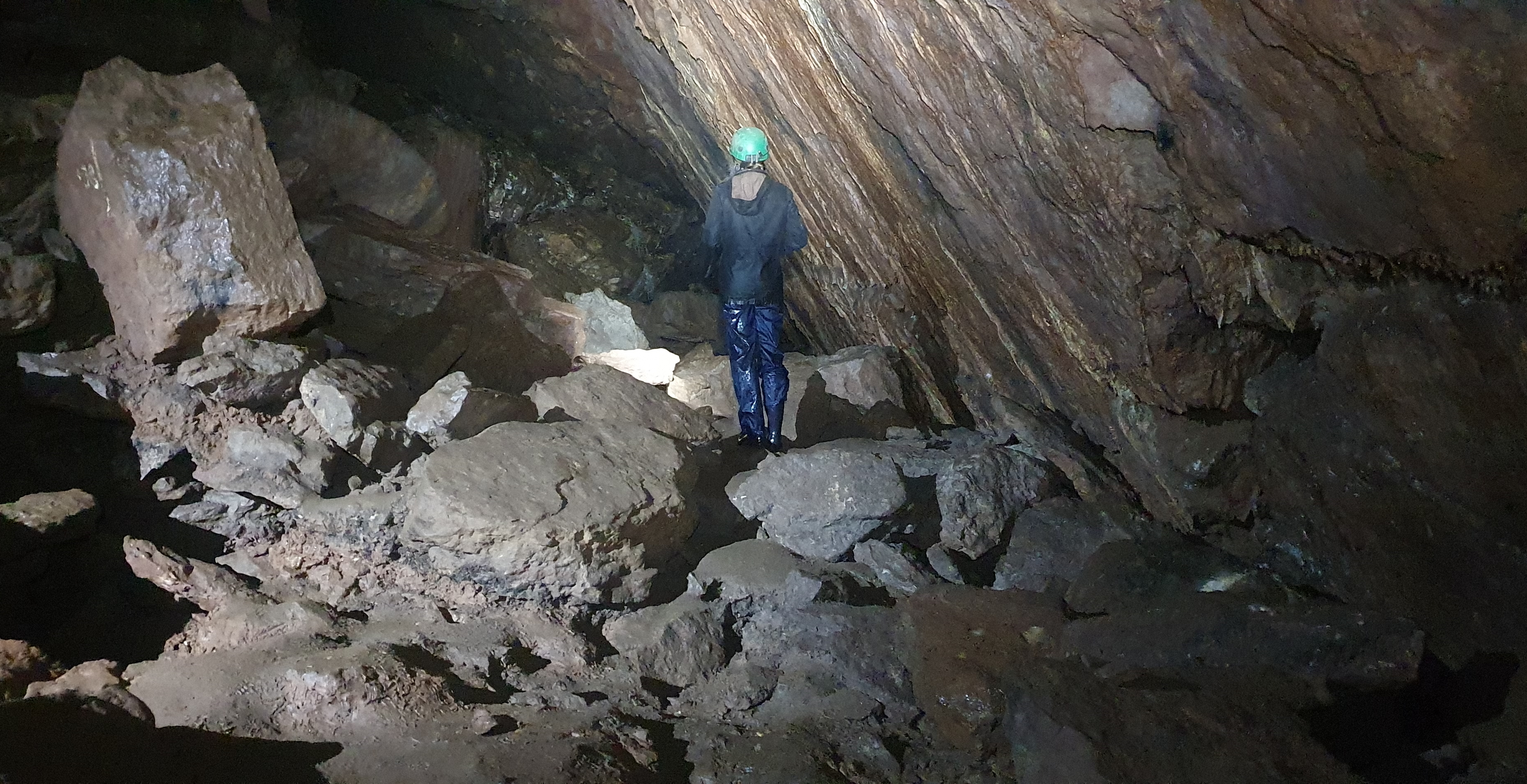
Alice Holland in the Main Chamber of Read's Cavern. Photo by Linda Wilson.
In preparation for an archaeological dig
next year, a collaboration between UBSS and the Department of
Anthropology and Archaeology, Kostas wanted to take a look at the site
of the last dig there in 2010, when UBSS caver Ruth Briggs found a
gorgeous little bronze brooch while doing some wet sieving.
Read's Cavern (originally called Keltic cavern) was excavated by UBSS
between 1919 to 1931. Layers dated to the Iron age were discovered.
Pottery, nave hoops, iron shackles, antler cheekpieces and animal bones
were included in the finds. An iron handle and bronze bands were
recovered from the cavern in 1919. The artefacts are thought to date to
the first half of the first century AD. Bone 'cheek pieces' are also
reported to have been found in the cavern.
The
2010 excavation suggested that the 1920s interpretation of a single
phase of industrial and domestic occupation in the Iron Age should be
modified. Although the main deposit was charcoal-rich there were no
signs of burning on the artefacts within it or on the surfaces beneath.
The material is interpreted as having midden-like origins and was
possibly placed in the cave in a structured manner.
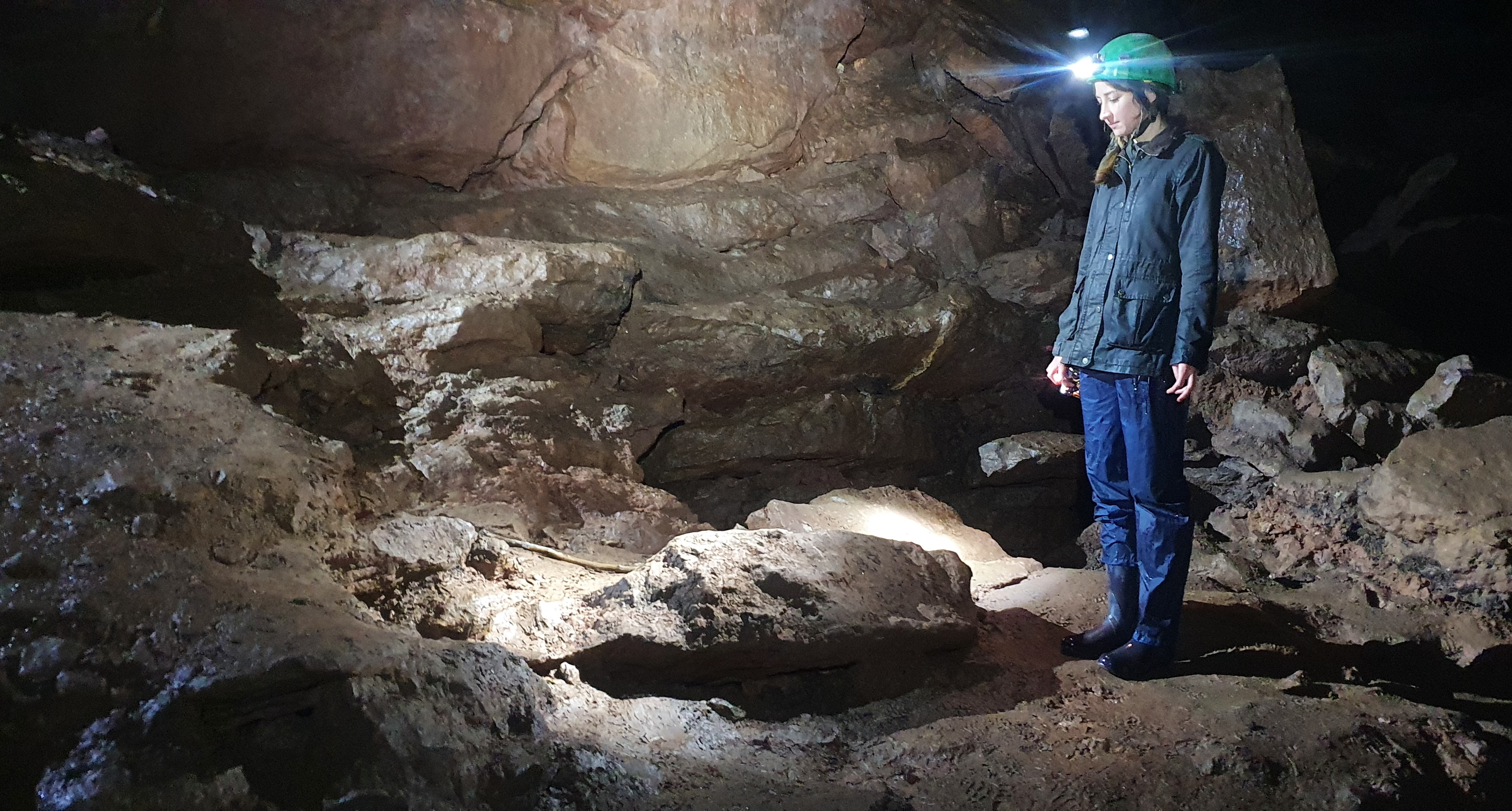
Alice Holland in the area of the 2010 dig. Photo by Linda Wilson.
The plan for the 2023 is to return to the
cave for ten days of fieldwork in June, to conclude the 2010 trench and
to conceptualise the finds. A full 3D scan survey of the main chamber
will also be carried out alongside micromorphological sampling, from the
trench profiles. Sampling for paleoenvironmental studies from cave
crusts and deposits will also take place.
A full analysis of any finds from the 2023 campaign will then be
analysed in context with the 2010 finds, to lead to the full publication
of the University of Bristol involvement with the site. The finds
discovered by the earlier UBSS excavations will also be revisited and
will be studied and recorded again, conceptualised with further
analytical work.
If anyone is interested in helping with this excavation, please contact me.
I'm pleased to report that Kostas stayed mostly dry, despite the
waterfall flowing down the entrance, and did get back in time for his
meeting!
Linda Wilson and Kostas Trimmis
|
|
WOULD YOU LIKE TO SUPER-SIZE YOUR ORDER?
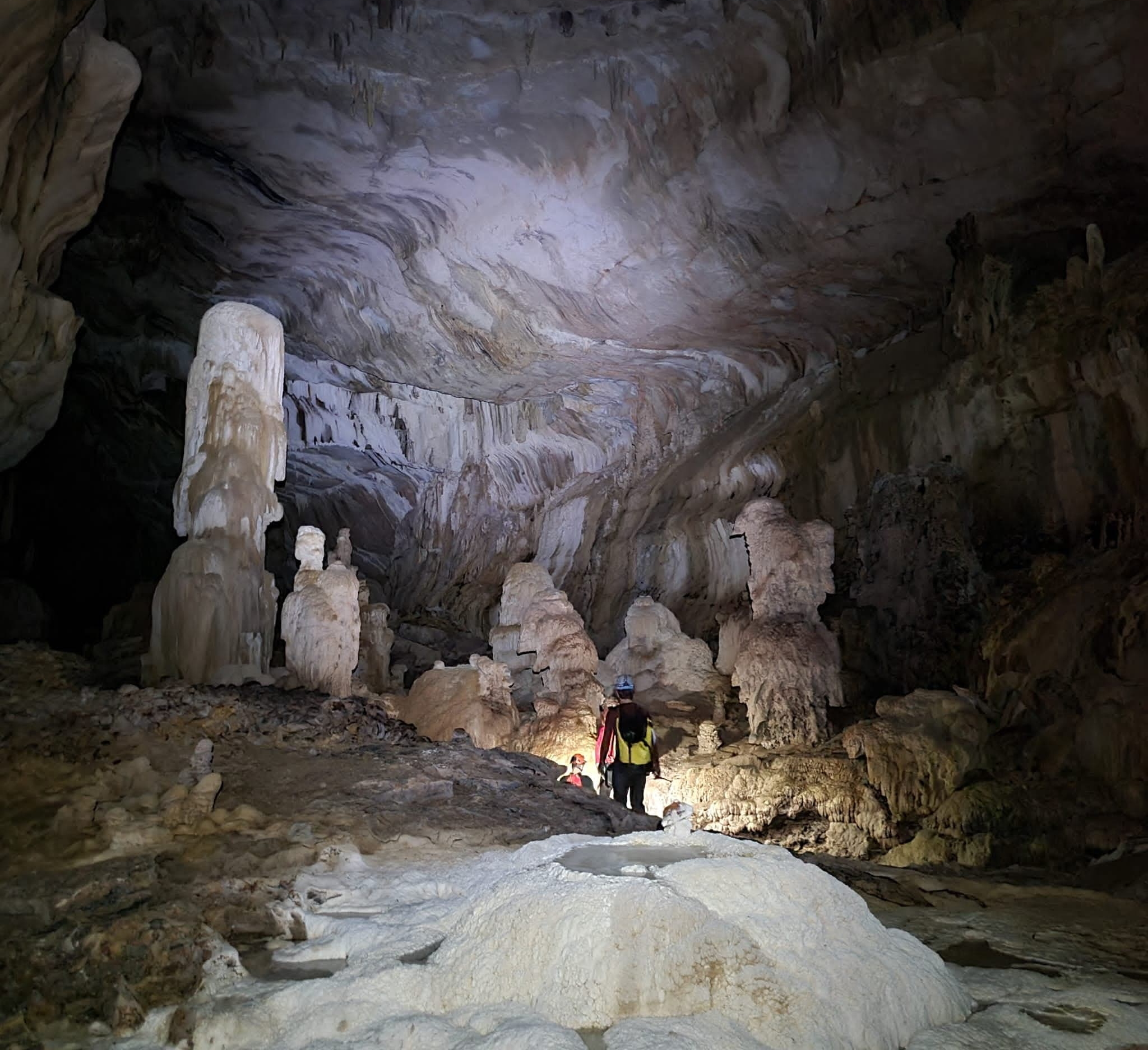
Easter Cave, photo by Max Koether.
There's no denying it, size matters in caving, and there's also
no denying that Mulu is the place to go if you want to super-size your
caving activities. Several UBSS members made it to Mulu this year (Ash
Gregg, Andy Farrant and Chris Howes) and Ash has kindly put together an
introduction to this year's expedition, with more detailed write-ups to
follow in future issues.
During November 2022 I was lucky enough to participate in the Mulu Caves
Project expedition to Malaysian Borneo. These caves are notable for
their gigantic passages, some of the largest in the world, and an
abundance of wildlife in the caves: including bats, swifts, snakes,
crickets and spiders. This year’s expedition was very successful with
the following outputs:
- 6.5km of new cave discovered and surveyed
- Cave
of the Winds was connected to Racer Cave via a 15-metre cave dive,
adding 11.9 km to the total length of the Clearwater system – now the
8th longest in the world.
- 5 km of cave passage re-surveyed to modern standards
- 3D laser scanning of over 4.0 km of the gigantic major passages.
- Multitudes of scientific experiments looking at cave formation and biology.
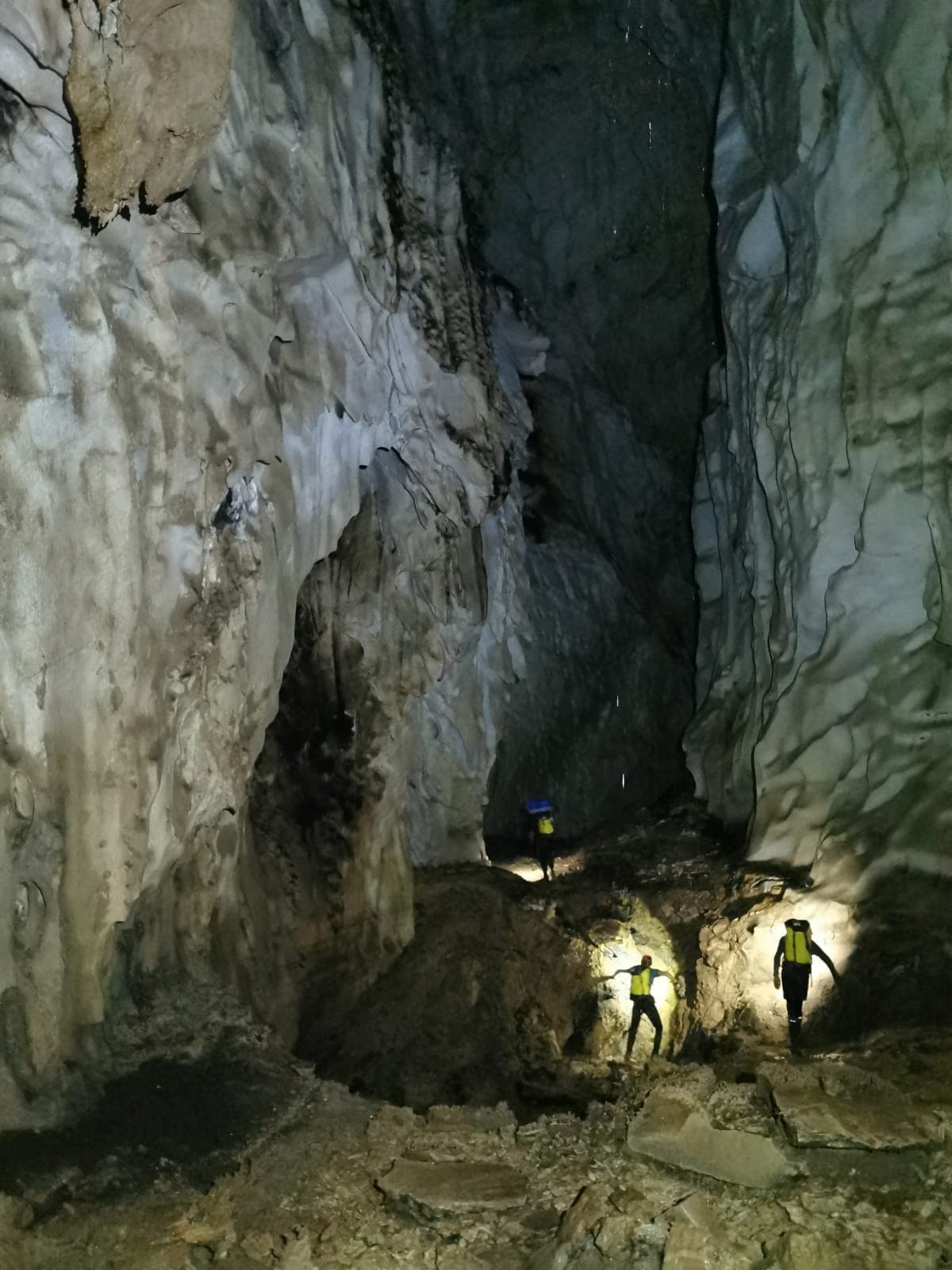
Revival, photo by Rob Eavis.
My main focus during my time in Mulu was
exploration and surveying. This included excursions into the Clearwater
system via Easter Cave, Racer Cave and Snake track entrance to Scumring
series. In addition, a couple of shorter trips into Lagang’s Cave and
Deer Cave. Many nights were spent camping underground to allow for
deeper exploration and discoveries, leading to a personal total of 214
hours underground over three weeks.
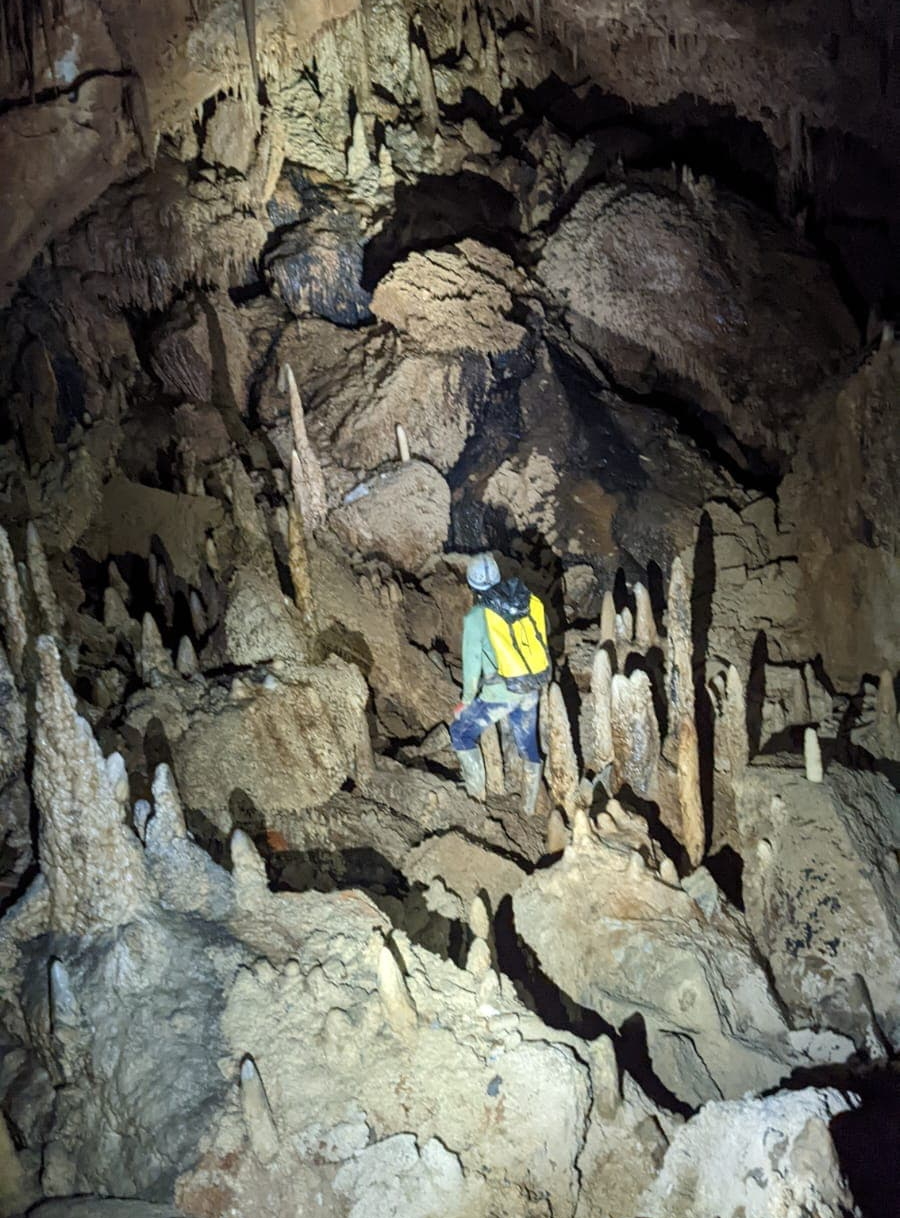
Near Armistace, photo by Will Pearson.
A typical trip to camp Scumring would
involve a 20 minute boat ride up river before an hour of hot sweaty
hiking through the rainforest.
Once in the cave the going was generally easier, through large walking
passage. This included going through Revival, a truly enormous passage,
as well as traversing around large holes, slogging up big boulder slopes
and skirting past vast quantities of guano. The camp itself was
pleasant with flat space to sleep, a reliable water source and lots of
nearby leads. I did two four-day camps to scumring with Rob Eavis, Will
Pearson and Andi Smith.
Ash Gregg
|
|
KENT'S CAVERN GRAFFITI PROJECT
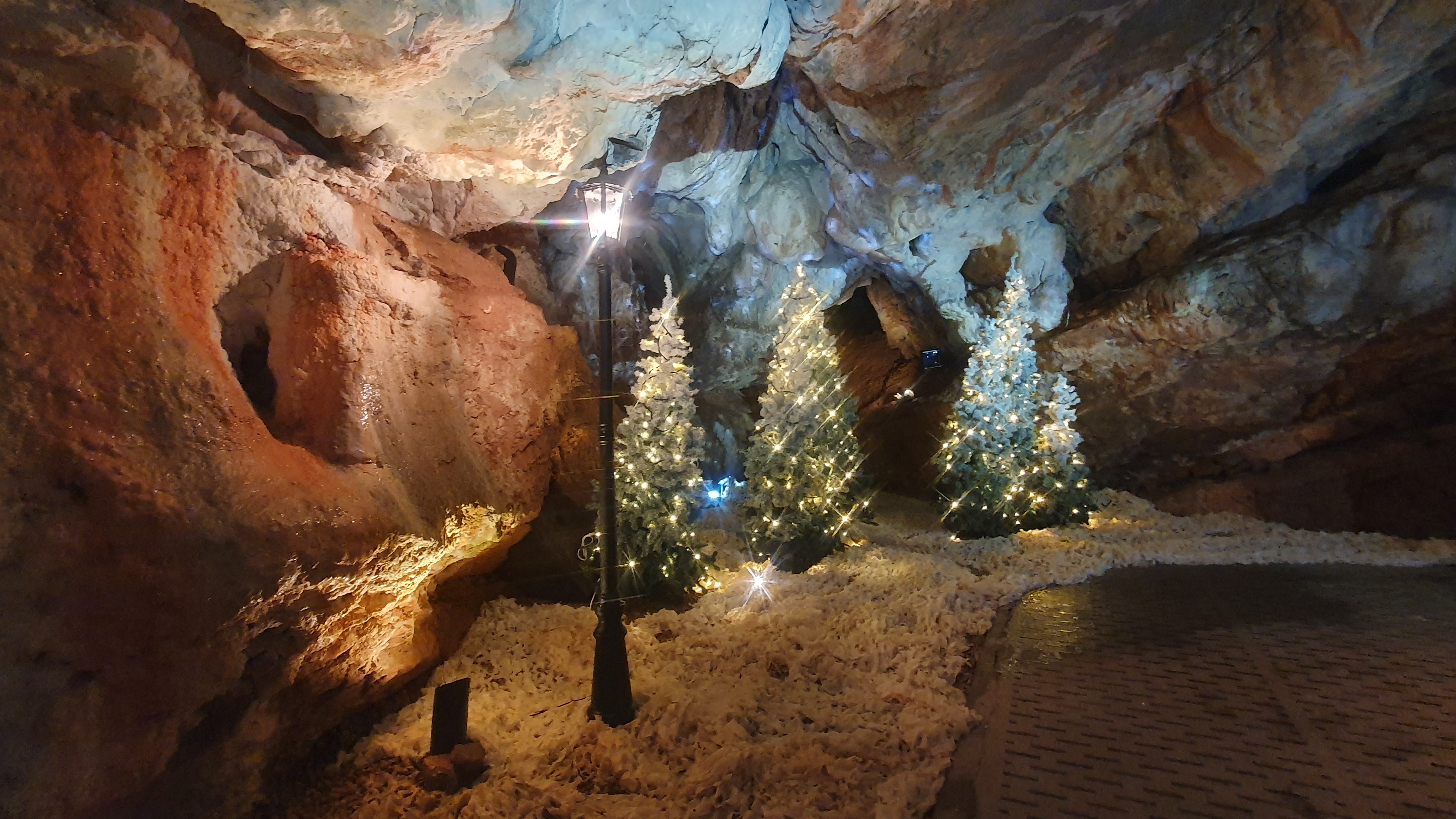
Come to Narnia, kiddies, we have Turkish Delight and puppies! Kent's at Christmas. Photo by Linda Wilson.
Anyone who's been reading the
newsletter for a while will know that Linda Wilson has an unhealthy
obsession with things written and drawn on the walls of caves and mines,
and has been steadily working her way forwards in time from the Upper
Palaeolithic to modern day. Her latest project involves undertaking a
survey of the historic and other graffiti in Kent's Cavern, Devon.
This project started with a campervan trip
to Devon for Graham and I, with the dogs, earlier this year. When I
realised we weren't very far from Kent's Cavern, a showcave in Torquay, I
emailed the manager, James Hull, to see if he was around for a catch
up, as I'd not seen him for ages. This turned into a trip around the
showcave on one of their guided tours and ended up with a chat about
historic graffiti in the cave. I agreed to look at taking on a project
to record the historic graffiti in the cave, as this is one of the aims
in their Cave Conservation Plan. The earliest known graffiti in the cave
is the name William Petre and the date 1571.
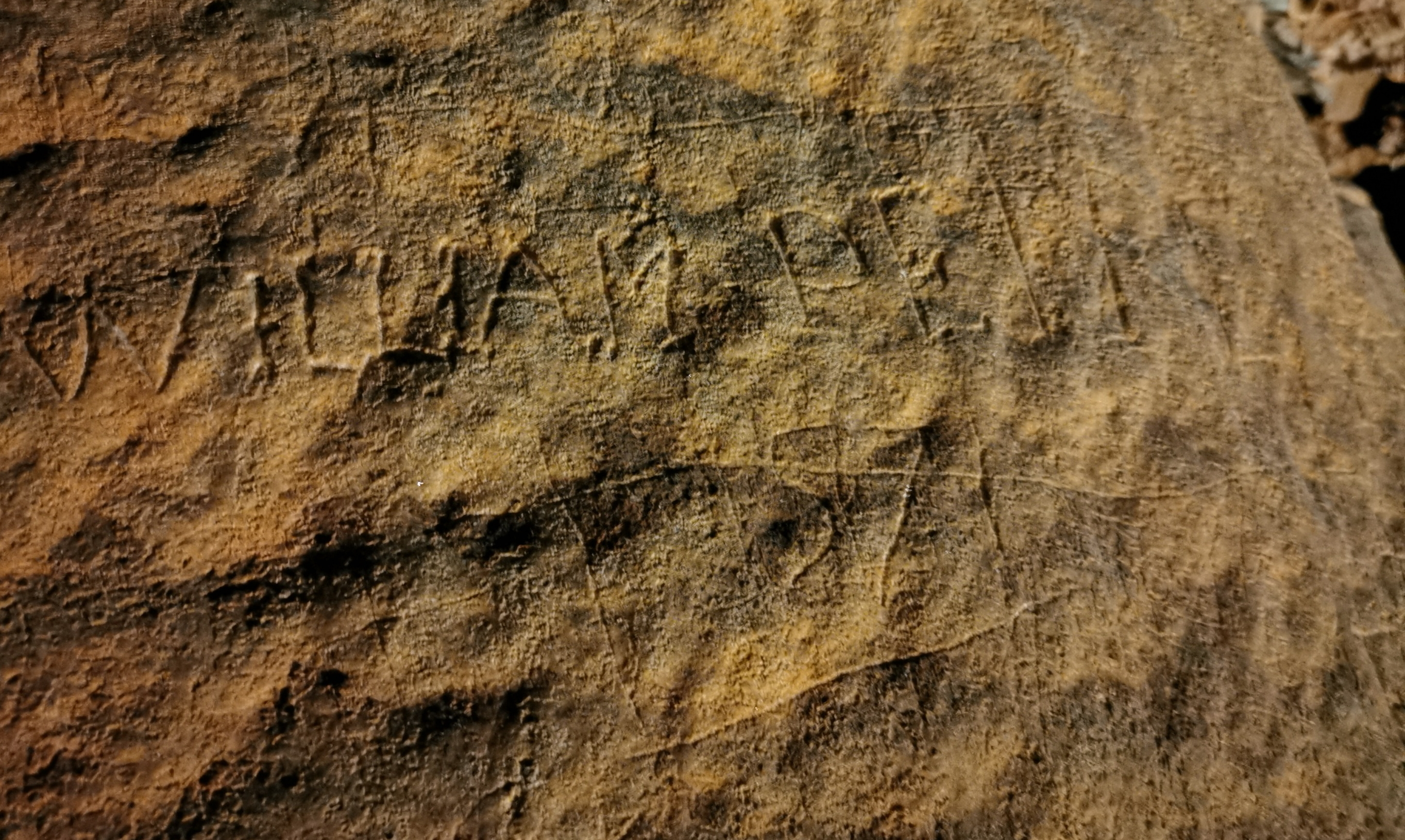
William Petre 1571, photo by Linda Wilson.
I talked about the project with my
collaborators on the website www.rakinglight.co.uk I run with two
friends, Anthea Hawdon and Rebecca Ireland, both of whom were
interested, especially Rebecca, as she lives in Devon not far from
Torquay. A further visit to the cave with Rebecca and Jan Walker to
check out the viability of this resulted in us booking in a week in
early January to work in the cave on a pilot study in the chamber known
as the Bear's Den, which contains the William Petre inscription. The
owner of the cave, Nick Powe, is kindly housing us for the week in their
on site AirB&B, formerly the owner's house. The team will consist
of (from UBSS) myself, Graham Mullan, Tony Boycott and Jan Walker,
together with Rebecca Ireland and Anthea Hawdon (Raking Light).
Rebecca has already put in a lot of work going through William
Pengelly's diaries and recording all the graffiti he notes having seen,
as one of our project aims will be to see how much of this we can still
find, and to ascertain whether any of this is now being lost to stal
growth.
Our most recent trip just before Christmas saw Jan, Rebecca and myself
going off the show cave route with Tara Beacroft, who worked at Kent's
for 11 years and drew up their excellent conservation plan. This was
Rebecca's first time caving and she took to it like a duck to water.
With the aid of a builder's ladder and a couple of slings, we made our
way up into Lake Chamber, an area of the cave where Pengelly and others
noted many inscriptions.
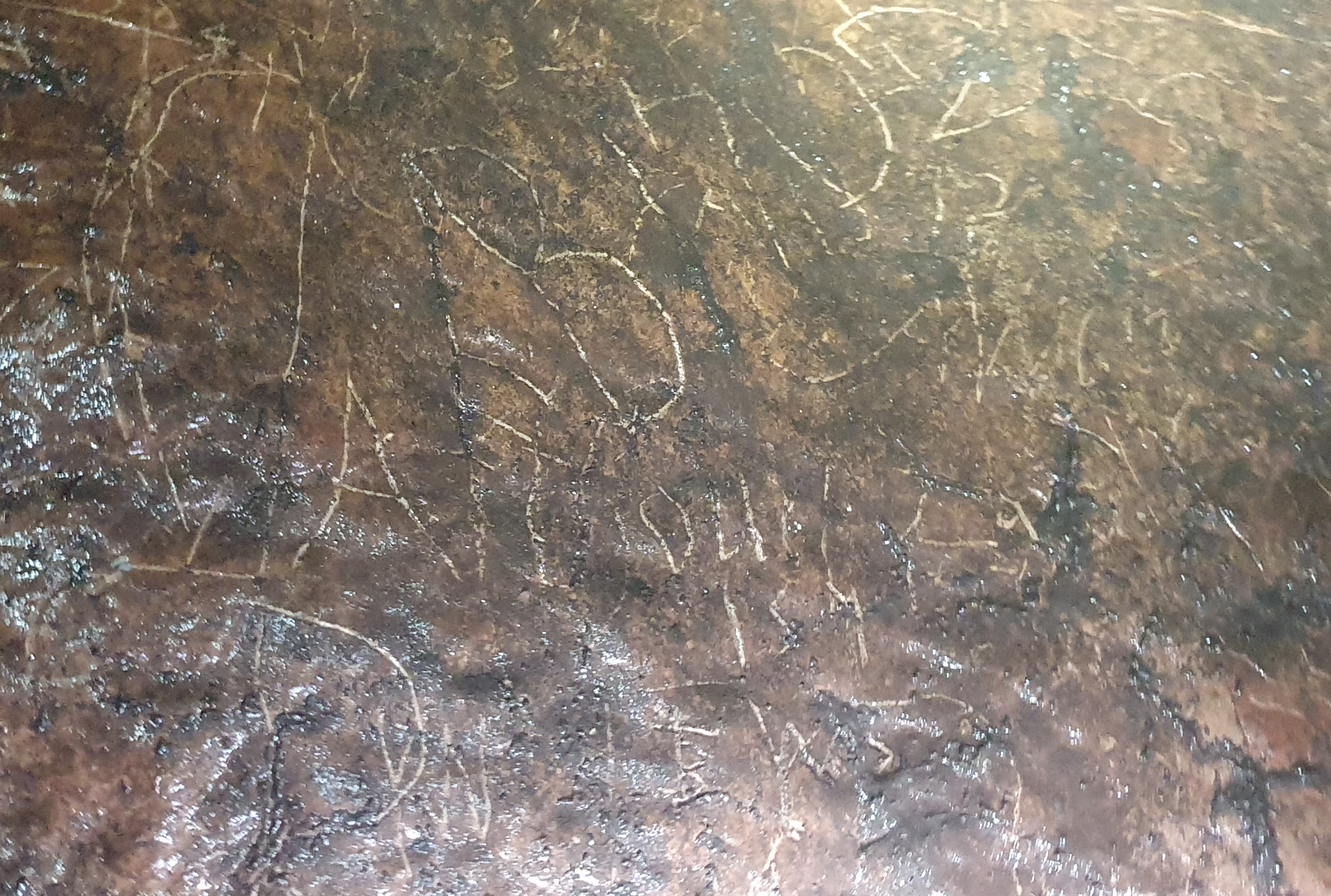
1571, below right of centre. 1702, top. Photo by Linda Wilson.
The small chamber is covered in historic
graffiti and Jan realised that I'd found something particularly
interested when I started emitting high pitched squeaks. Rebecca was
called in to verify what I thought were two more early dates, one from
1571 (the same date as the William Petre inscription) and the other from
1584. Also, while checking this photo again, I saw what appears to be a
1572 just below the 1702. There were other dates from the 17th and 18th
centuries nearby. The temptation to sit there and keep hunting was
overwhelming, and we were also dying to decipher any names close to the
dates, but we needed to time our visit to Lake Chamber to get down
before the next tour arrived in that part of the cave, so after a brief
visit to the inscriptions by Jan, we headed back down the ladder and
made our way out, via a trip into some of the side passages near the
entrance.
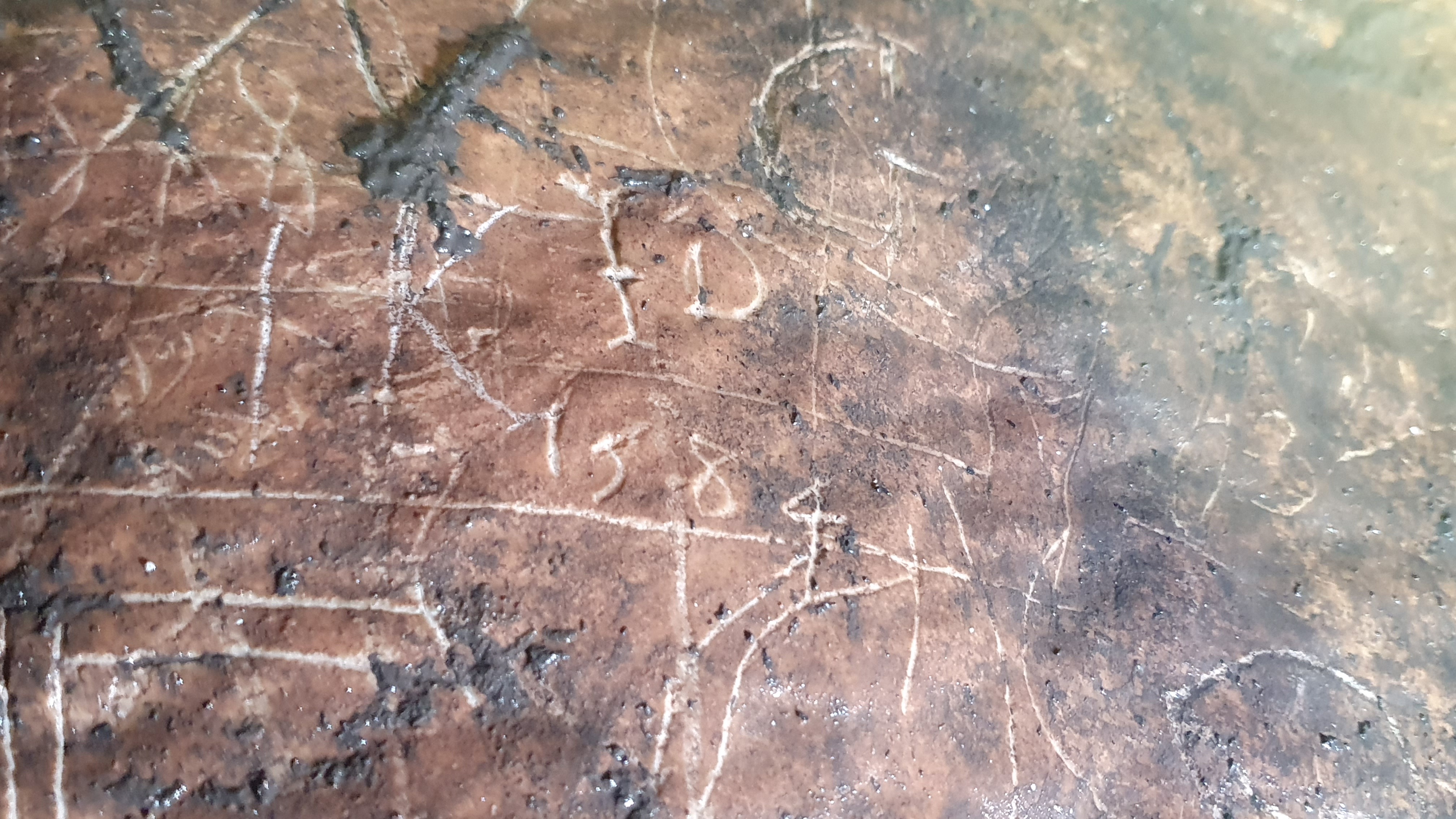
1584 (centre). The angular 5 and the straight topped 8 are very characteristic of the period. Photo by Linda Wilson.
This will be an ongoing project for a couple of years at least, so if anyone would like to get involved, please get in contact.
Linda Wilson
|
|
INCY WINCY SPIDER ...
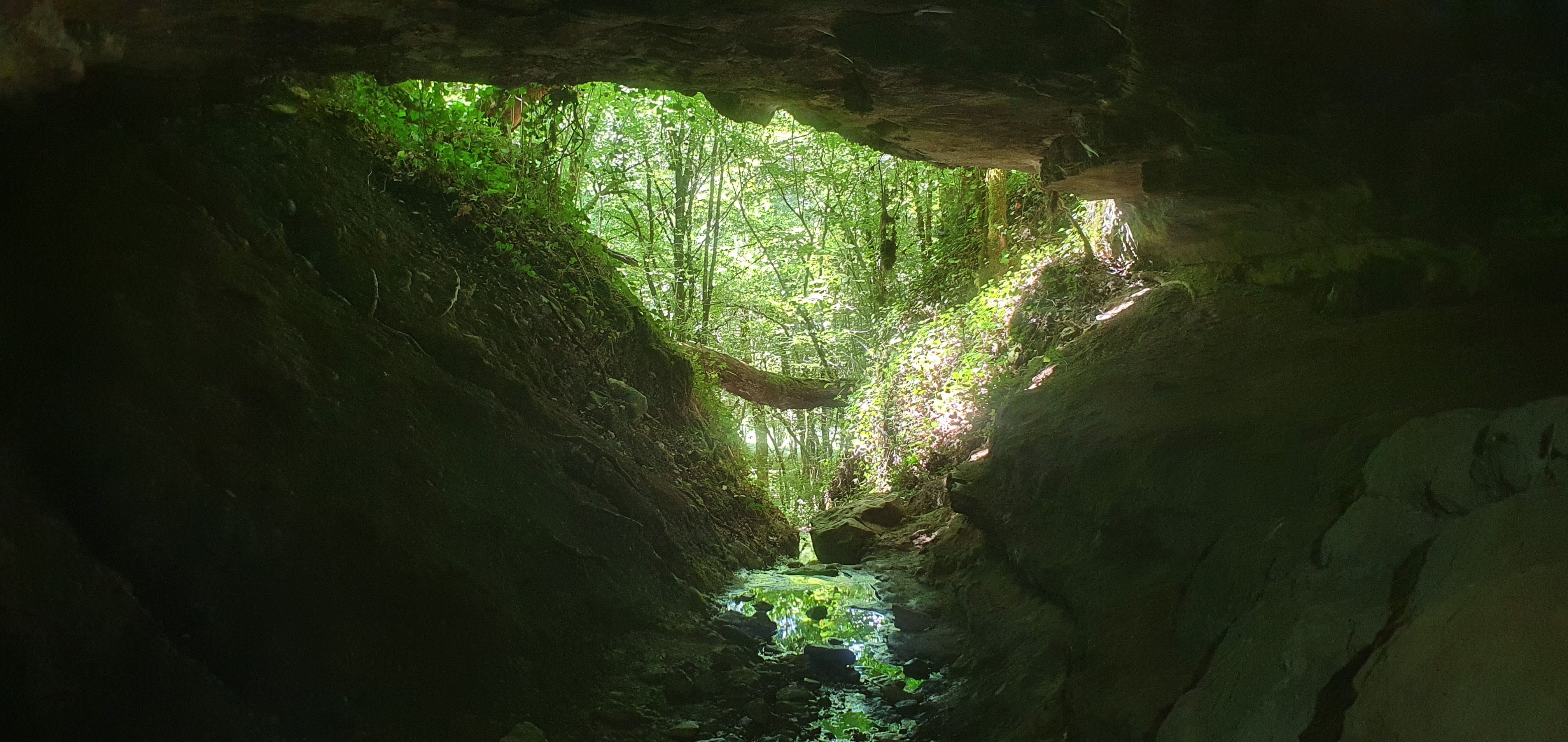
Grotte de Douyme II, entrance looking out. Photo by Linda Wilson.
During a French trip in the summer,
Linda Wilson and Jan Walker paid another visit to the smaller of the
two caves near the ruined mill north of Azerat in the Dordogne to take a
few more photos.
Grotte de Douyme II is a straightforward meandering streamway very
reminiscent of many caves in Co Clare, Ireland. To find it, locate the
village of Azerat in the Dordogne, then follow the map shown below to
the parking place on the left of the road. Almost opposite, on the other
side, there's a track leading down into the valley. Follow it down and
down, and then down again until you reach the bottom of a deep valley.
Carry on until you reach an old mill leat on your right and the ruins of
an old building. There's a path leading along the leat. Follow this
ntil you meet a streeam coming down from your left, then head up hill on
the right bank until you see a fallen tree in front of an obvious
entrace. Well done, you've arrived.
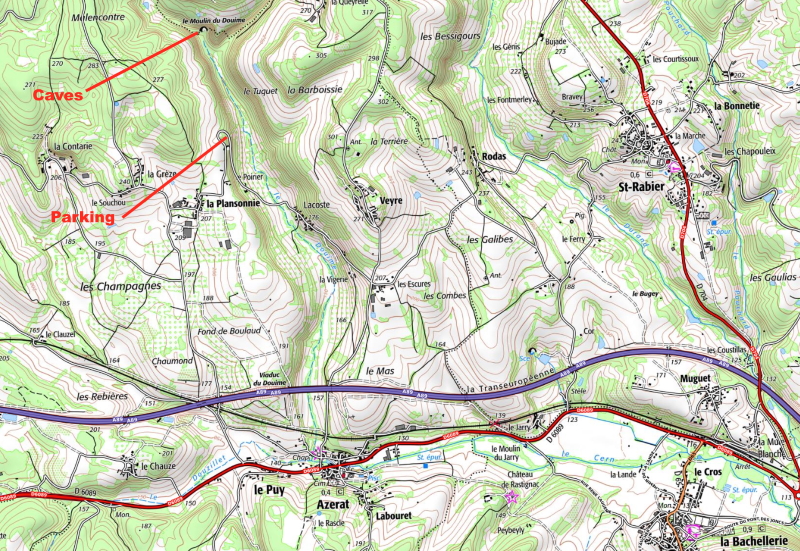
Once in the cave, there are zero route finding options. Just follow the
stream. A hell of a lot of greater horseshoe bats roost in the cave in
winter, along with lesser horseshoes, so don't visit in hiberation
season. In places, there is a very strong smell of bat urine, and it's
advisable, as well as pleasanter, to wear a face mask when you start to
notice that niff in the air. Er, and the fuzzy lumps floating in the low
stream in places are the remains of the bats that didn't make it
through the winter. This is a very good cave for studying dead bats! You
can find them still clinging to walls high up, and some that have
fallen off. There are also large piles of guano in places. But in
summer, it's pretty rare to see any live bats. You usually encounter a
couple flying around in the entrance passage, but that's about all.
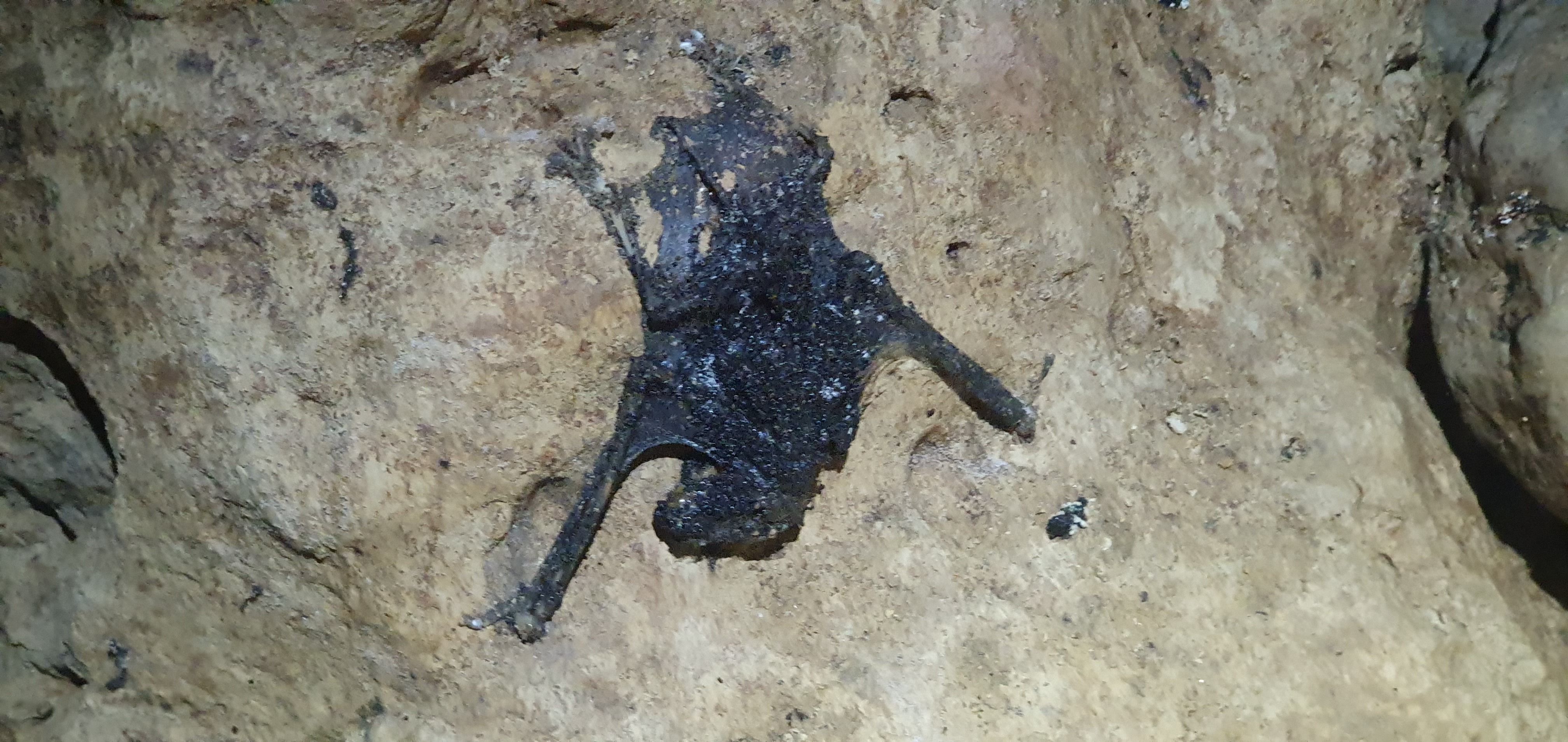
Dead bat. Photo by Linda Wilson.
The passage ends in the sort of bloody
great big choke that if it was on Mendip would have already seen feats
of massively improbably engineering. But there are few diggers in the
area, so if you want a project ...
WARNING: ARACHNAPHOBES COVER YOUR EYES NOW!
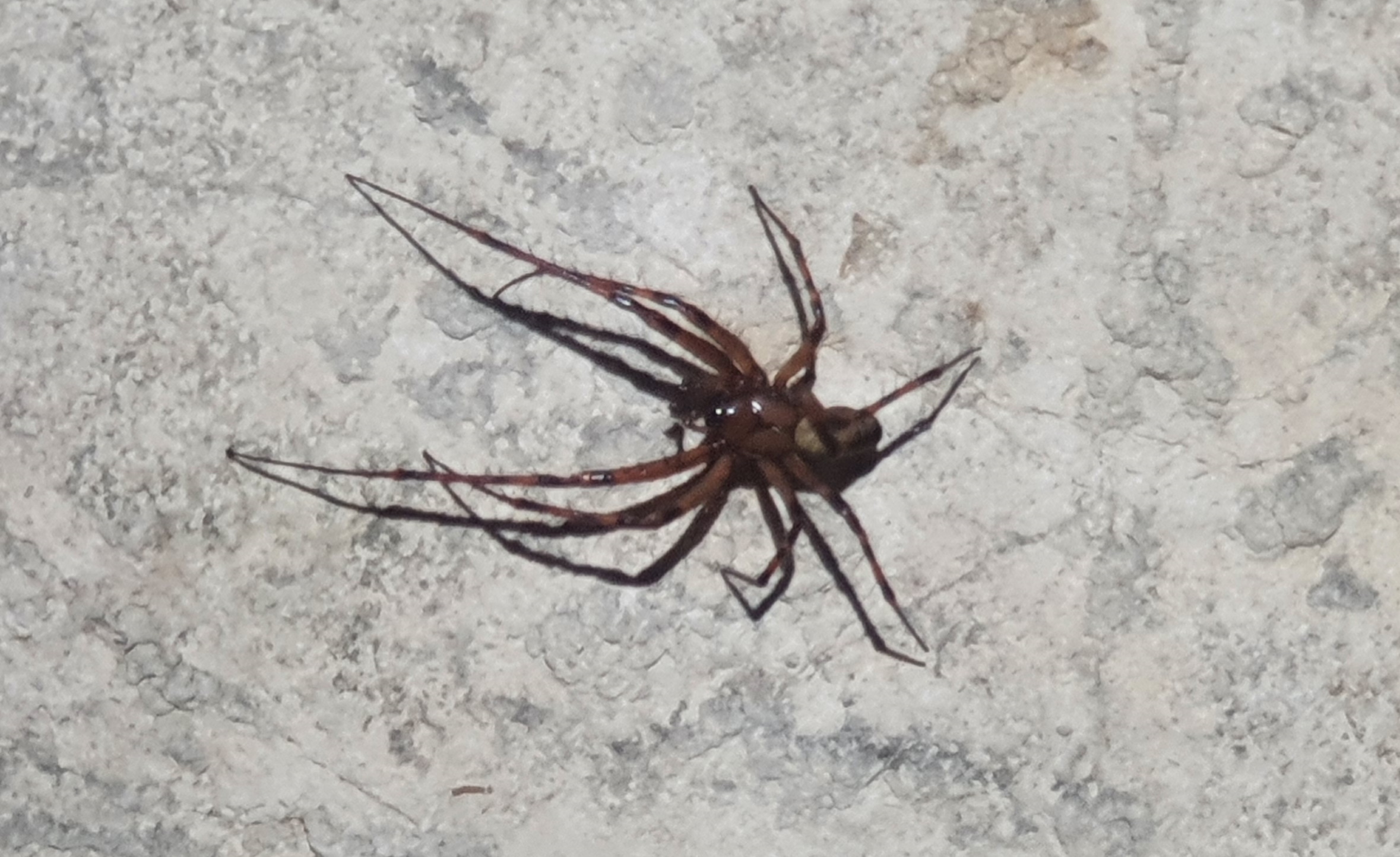
Meta menardi. Photo by Linda Wilson.
On the way out, took some dead bat photos
and some of a large spider in the entrance. I showed this to UBSS member
Colin Rogers who knows a few things about cave spiders and he showed it
to another spider expert. The consensus of opinion is that it was a Meta menardi. This
is a common spider to find inside cave entrances. Charlie Self always
used to refer to it in the vernacular as the 'fat brown spider'. I
remember from a cave biology talk I heard a few years ago that they can
live up to ten years!
I also played around with photos of reflections in the stream.
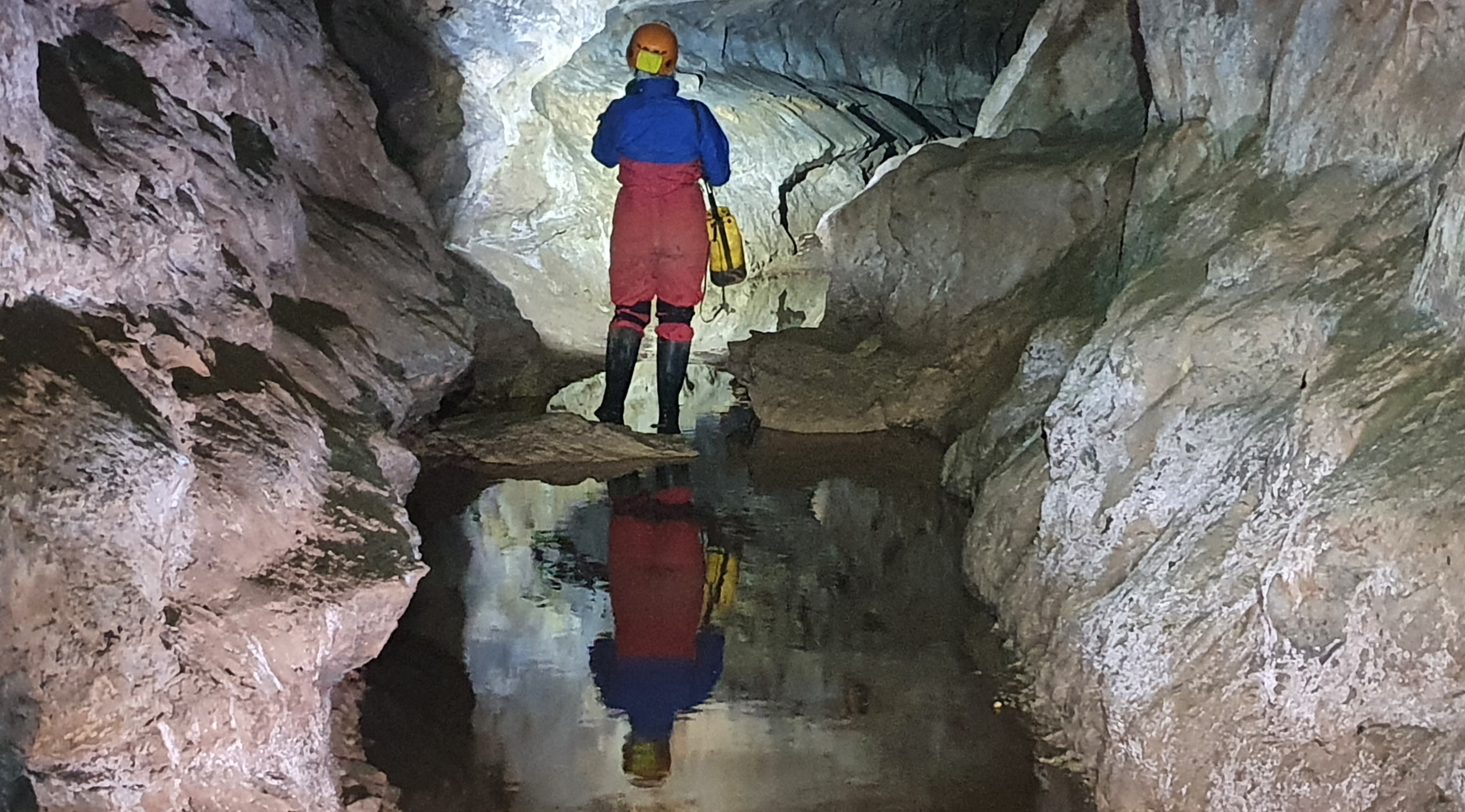
Jan Walker. Photo by Linda Wilson.
A little way further up the valley to your
right (when facing Douyme II is the unsurprisingly named Douyme I cave,
which contains the largest chamber in the Dordogne, written up in an
earlier newsletter. Just follow the stream and make your way behind
another ruined mill building.
Both caves can be combined in a pleasant couple of hours wombling around a very pleasant area.
Linda Wilson
|
|
I READ TO THE END, REGINALD! I DID, I DID!
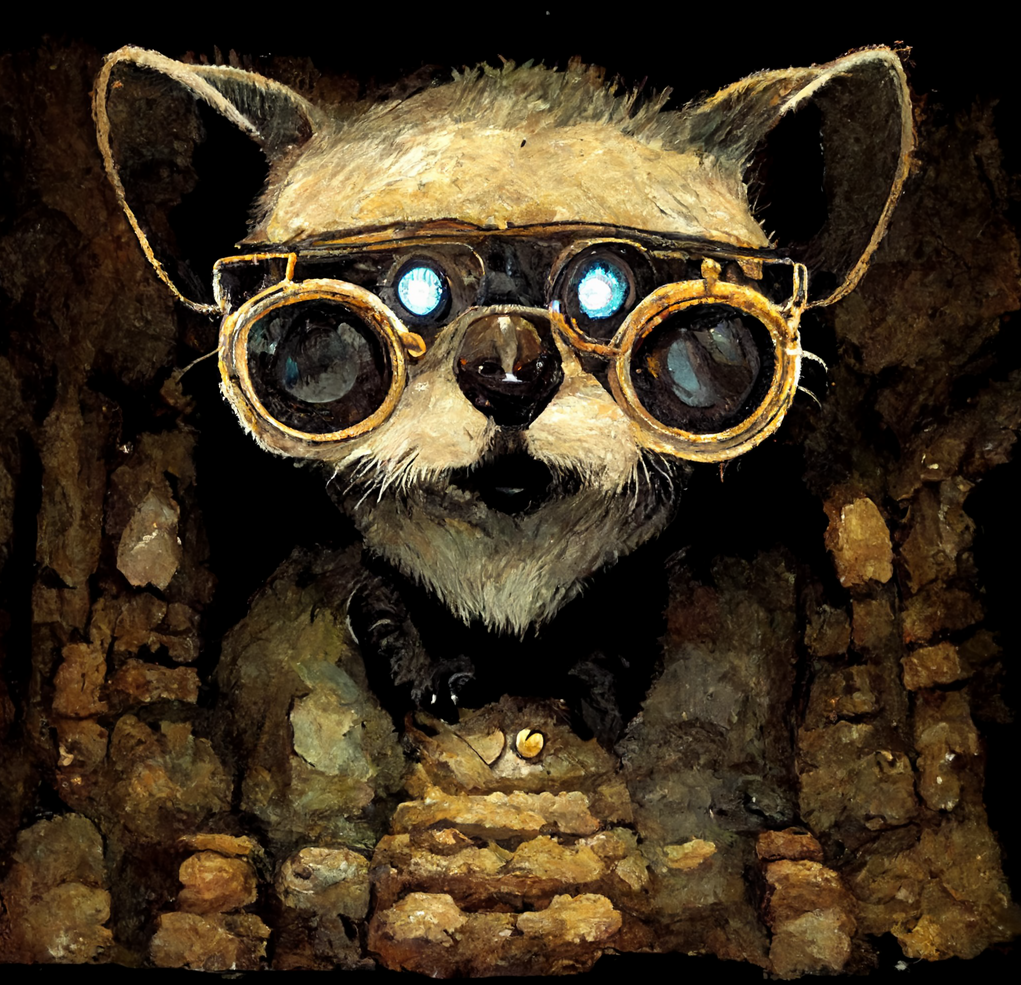
Reginald was created with the help of the
Midjourney AI art generator from the prompts 'steampunk raccoon in a
cave'. If anyone else fancies playing around with Artificial
Intelligence art generators and creating some more cave critters in
glasses for 2023 newsletters, we'd be very grateful!
Let's have a round of applause for
Jake Reich whose speed reading brought him home to a very respectable
first place last month! A prize will be winging its way to him when term
starts again.
In the meantime, there are still prizes to be won in 2022! So let our
latest mascot, Reginald, know when you've made it this far and we'll add
you to the 2022 Hall of Fame.
- My fav pics in this edition: Ash's Salamander and Cave Baby, [Jake Reich]
- Rufus is just as adorable as Chloe! Super newsletter, lovely
caves, and I do want to go to Alderley Edge one day. Congratulations to
the grads! It was interesting to see the eastern US caves, having only
been to TX caves. And the filming day at Aveline’s was cold, damp, but
fun. They were pretty nice people. PS Mia’s sign-off of ‘worm wishes’
made me giggle. [Jan Walker]
- Hope the Scottish UBSS enjoy the Elphin Hut….and look over the Moine Thrust! [Eve Gilmore]
- Fab read as usual. Appropriate procrastination as I hype myself
up with a strong coffee for my deadline which is in 1.5 hours (I snoozed
my alarm for 2 hours this morning). Especially enjoyed our new members’
write ups – so happy to hear they have enjoyed discovering
caving! [Mia Jacobs]
- Excellent newsletter, as always! Linda, your description of
exploring the mines (“going feral”) on Alderley Edge as a girl rang
bells with me! I grew up in Bramhall, about 6 miles north of the Edge.
As teenagers in the early sixties we would often cycle over to the Edge
with friends to race around the many hilly paths there on our bikes.
Sometimes - without telling our parents - we took torches to explore the
mines. We didn’t go in very far, with stories of people dying after
falling into hidden shafts putting us off, but it was great fun. Gates
started to appear on some of the entrances, but were often broken or
easy to bypass. Great to see photos of how it all looks now. I was not
aware that the mines were so extensive. [Bob Taylor]
- I'm late to the party, as I've spent the day shovelling shit at
high speed! Really enjoyed the Alderley Edge and the filming at
Aveline's reports. I remember going into the mines when we all went up
to Cheshire for that Alan Garner weekend. And I am still tittering at
the film company's impression of Linda! And hey, doesn't George have
groupies already? [Toodle pip from Sharon Wheeler and the blessed
FT Bear!] [Editors' Note: Yep, George 'The Talent' Nash has had groupies
for ages, he's a star, dahling!]
I did it Reginald, I read to the end!
THE END
|
|
|
|